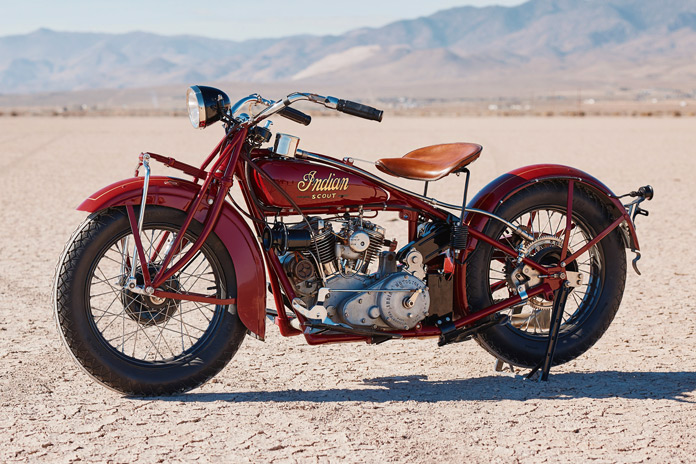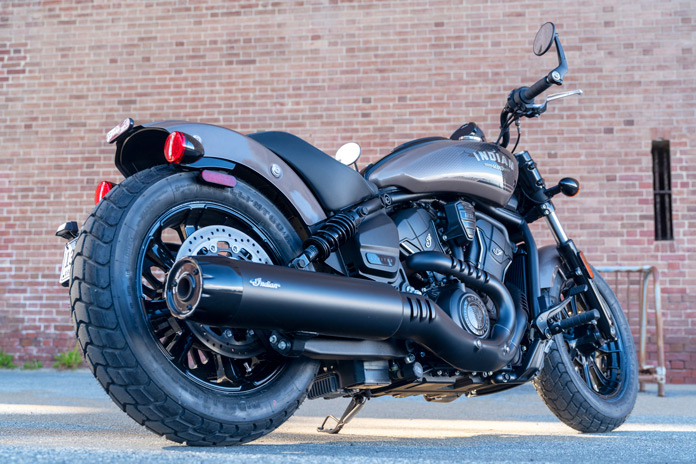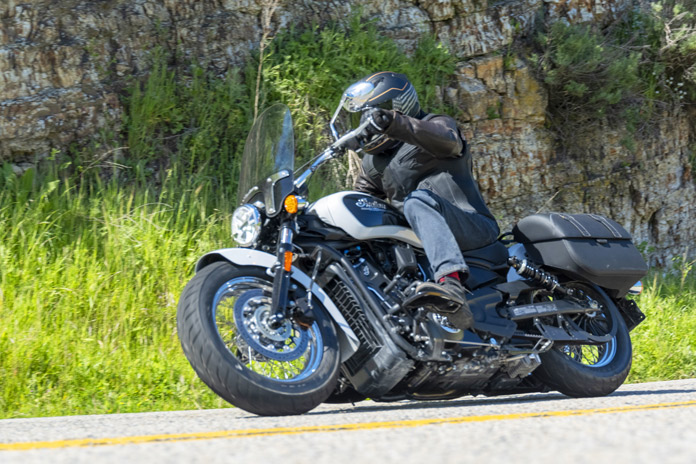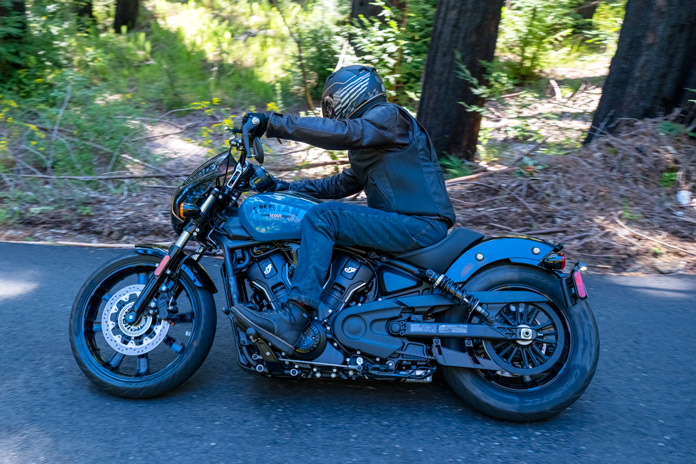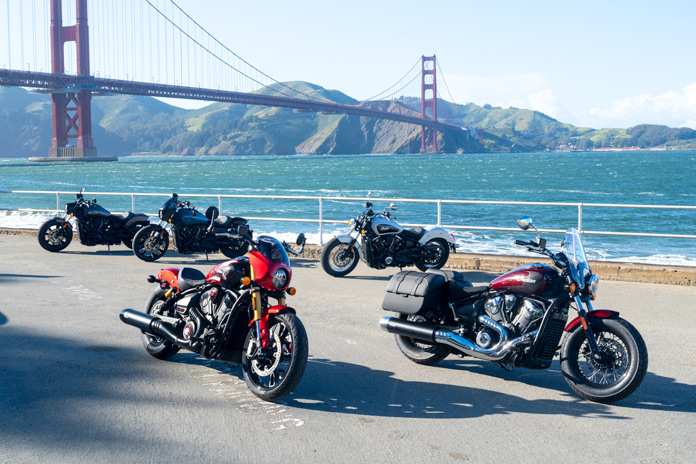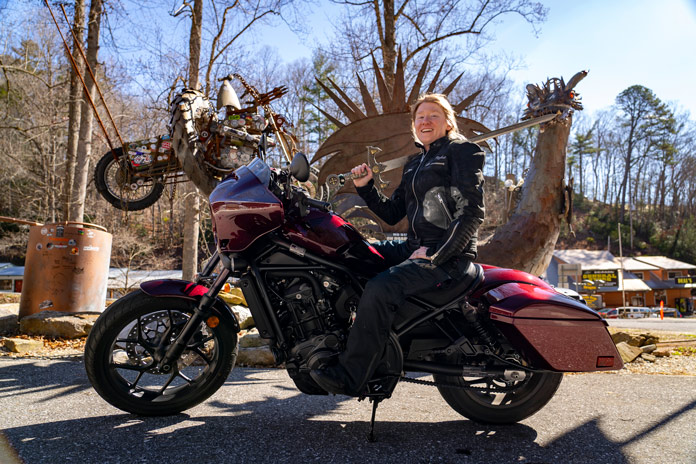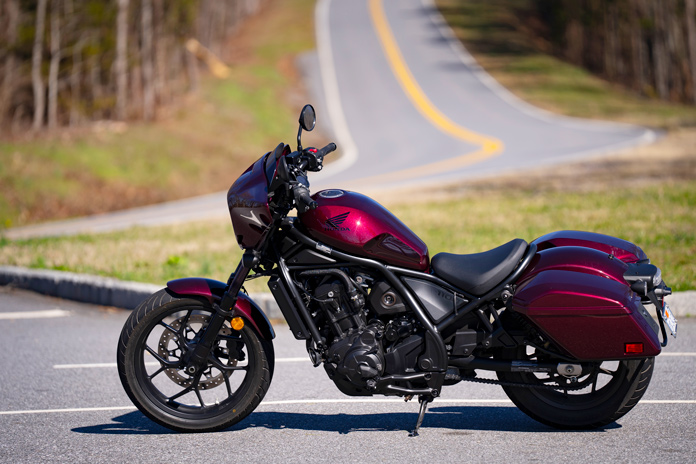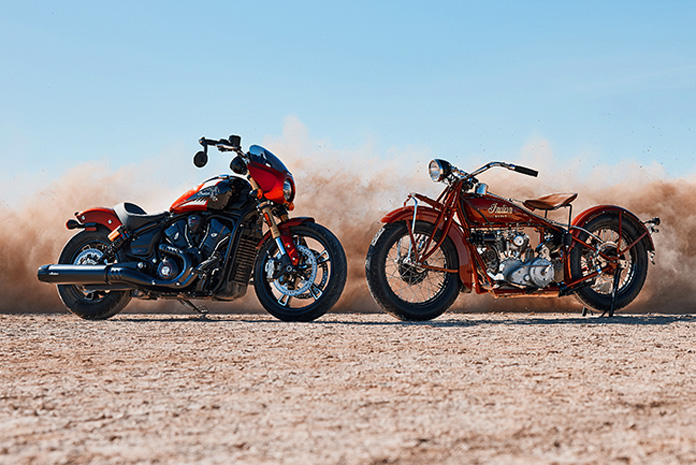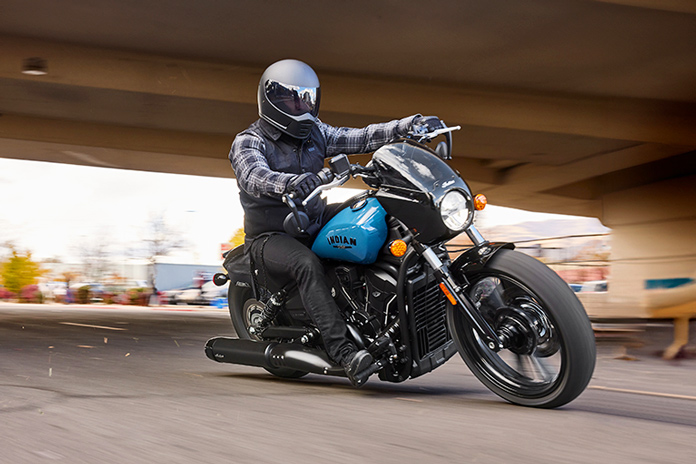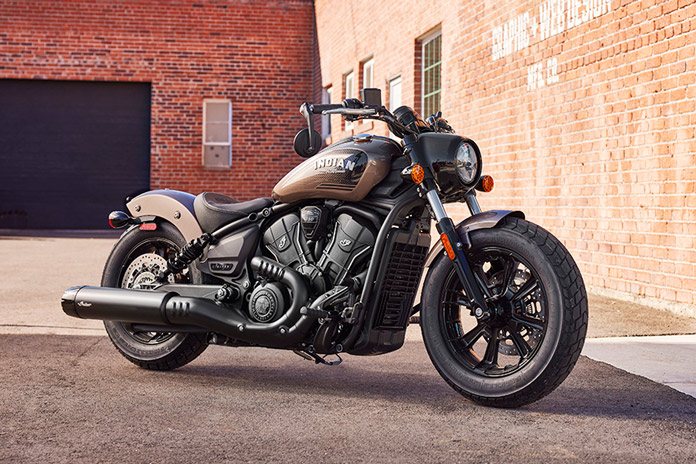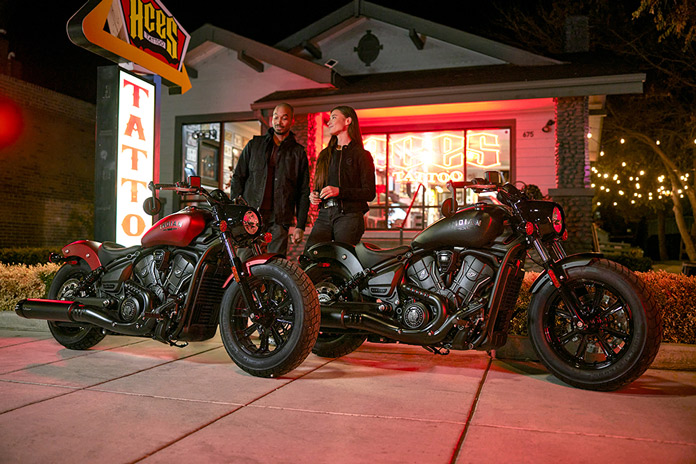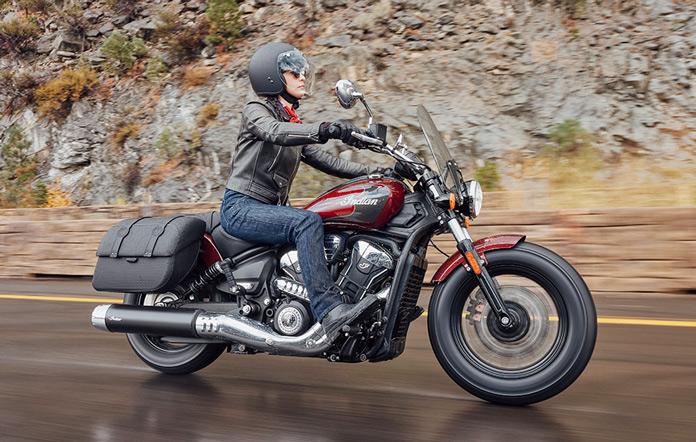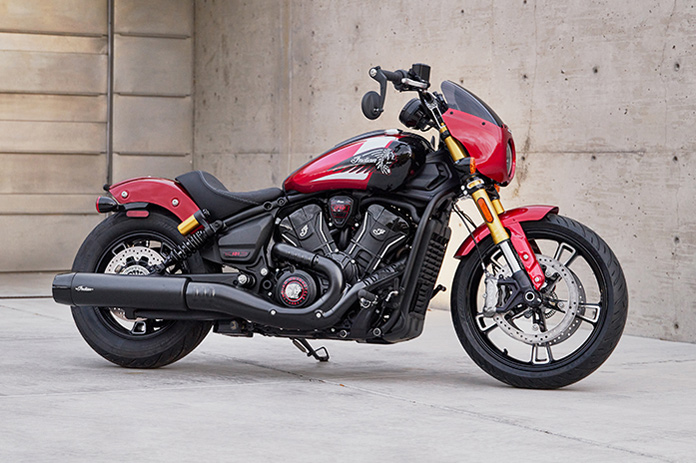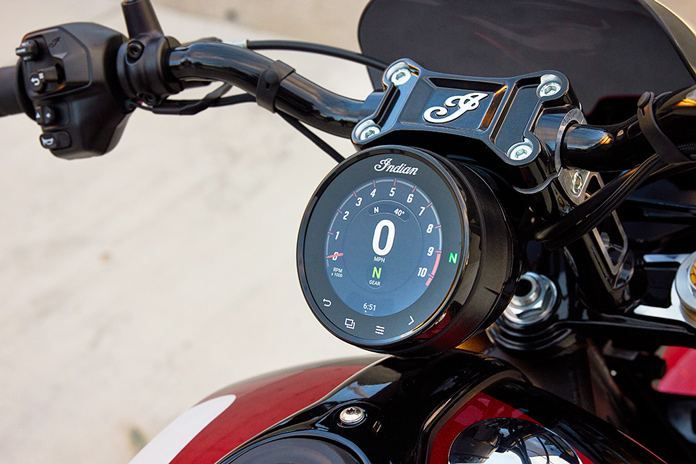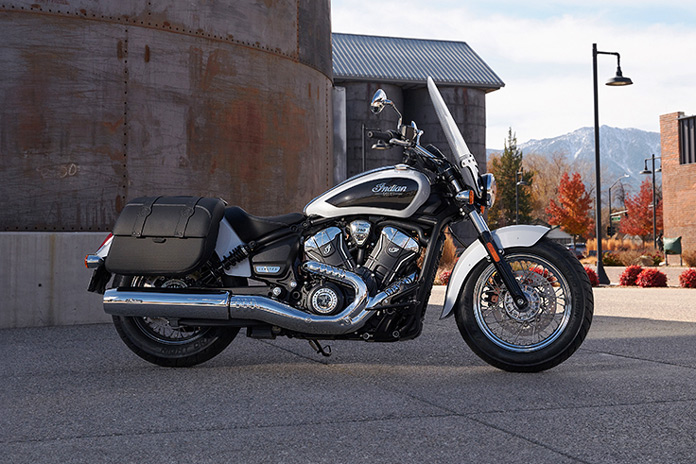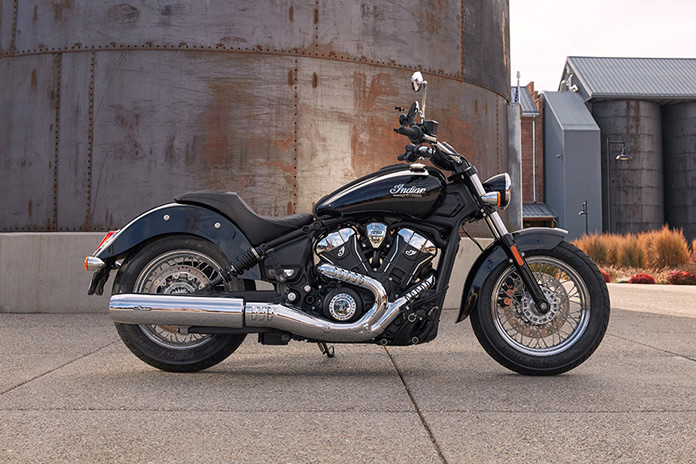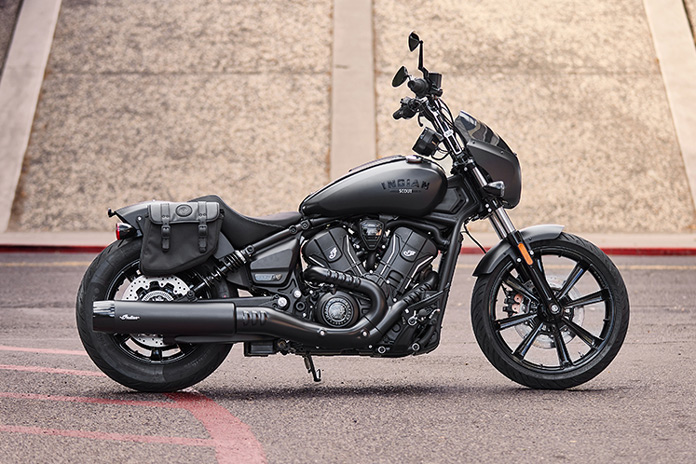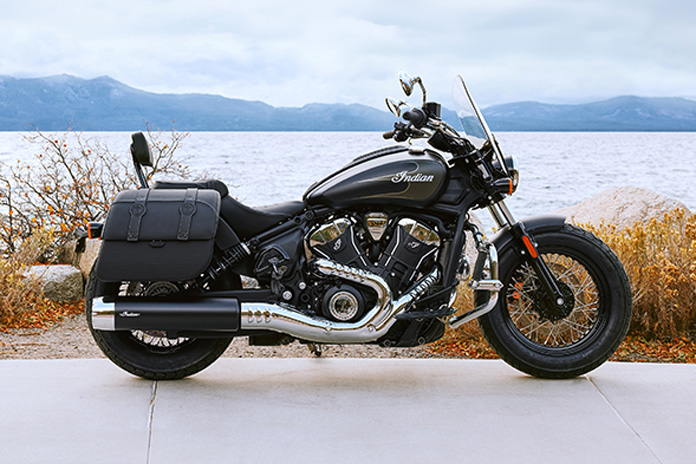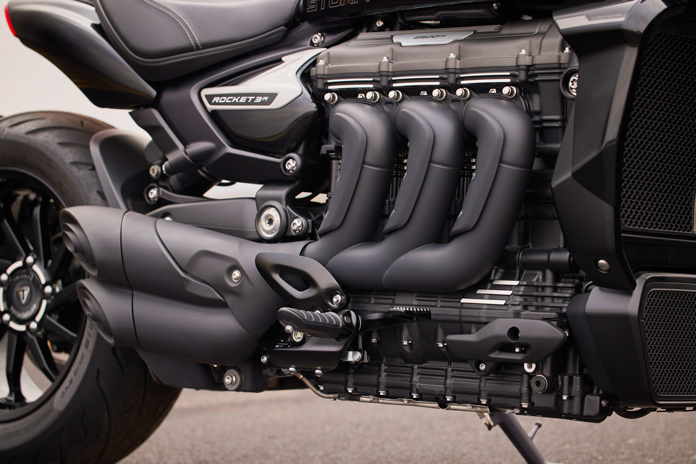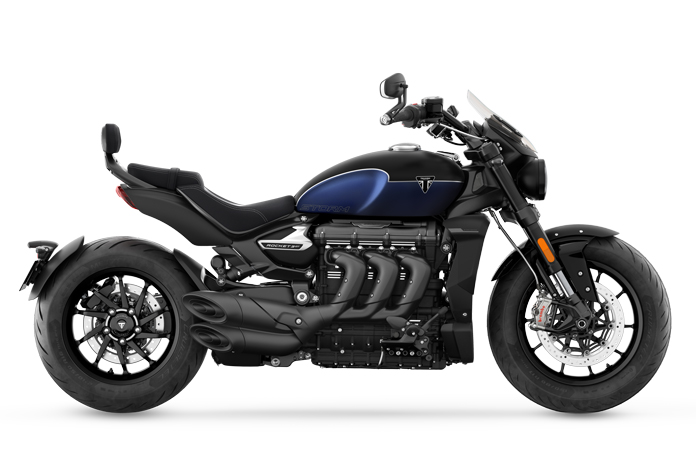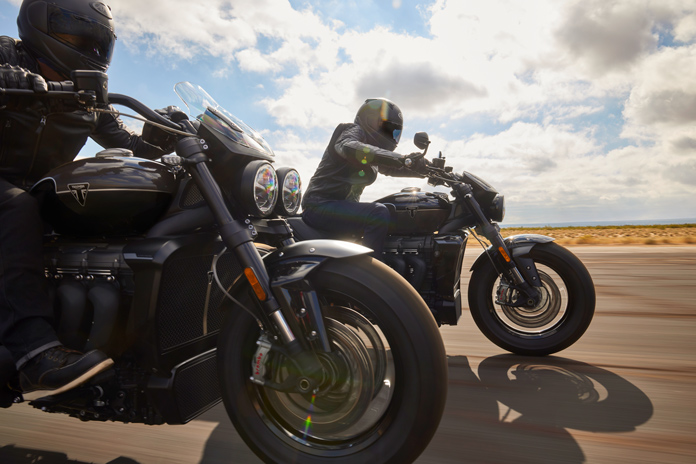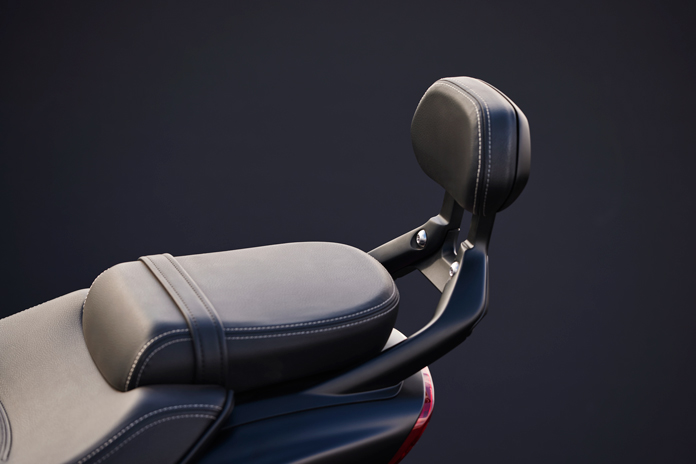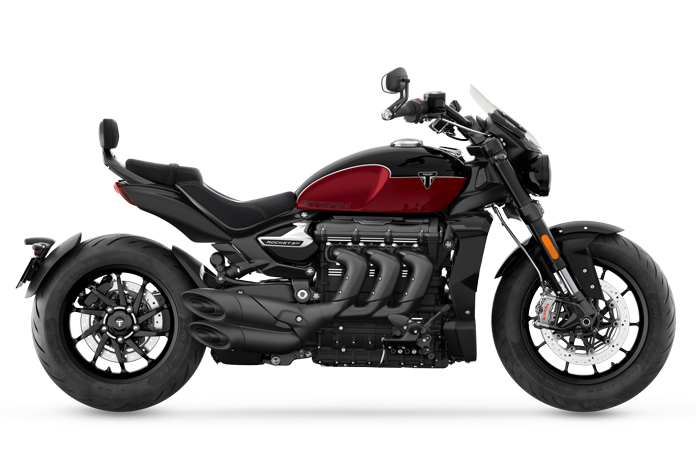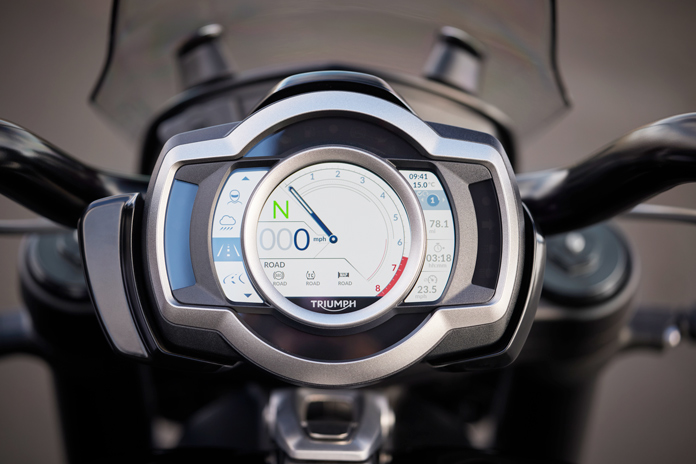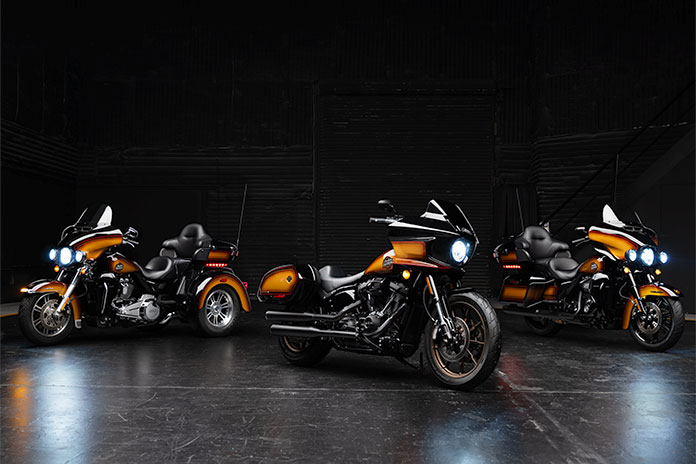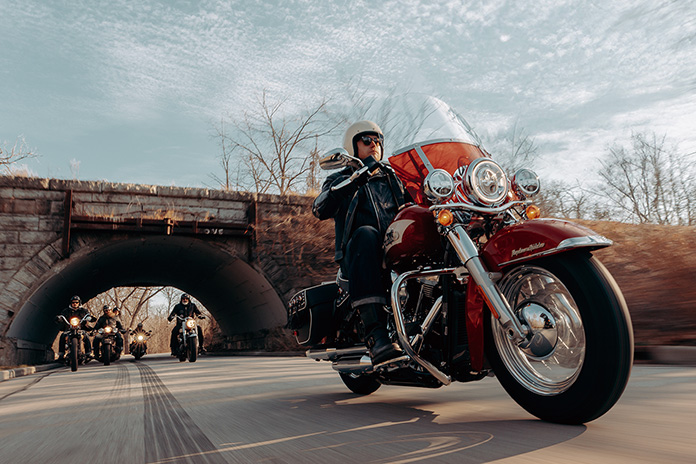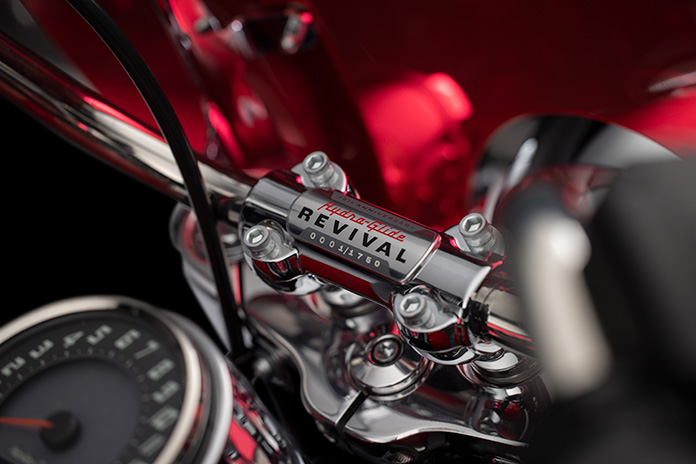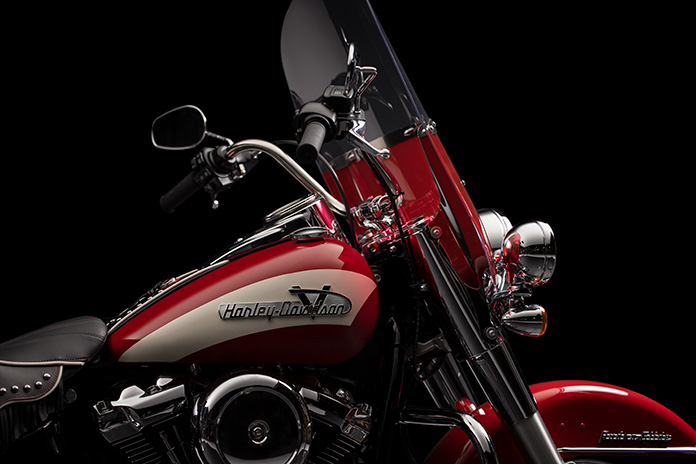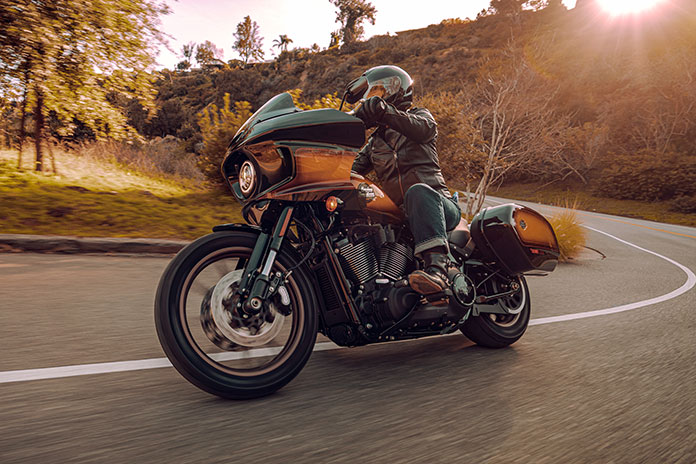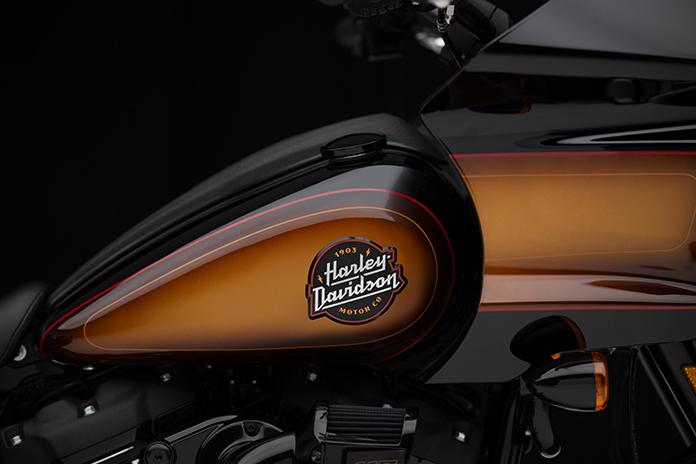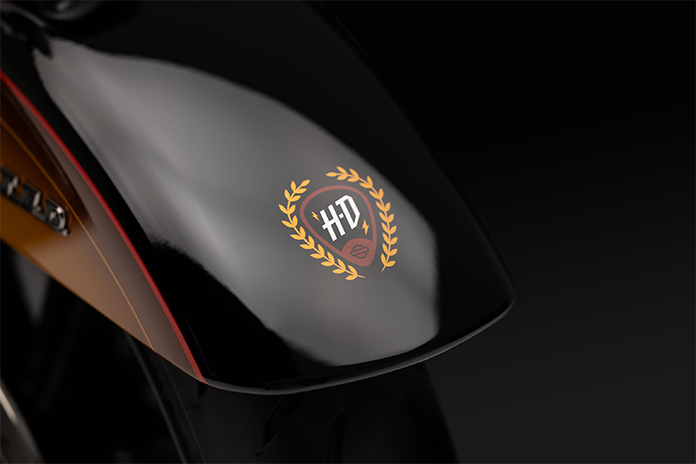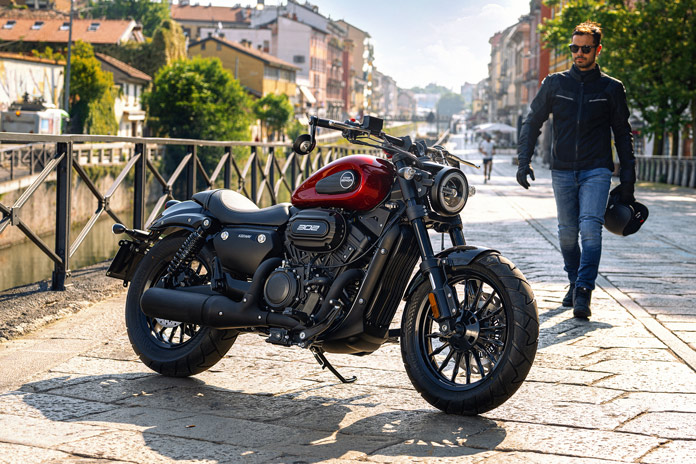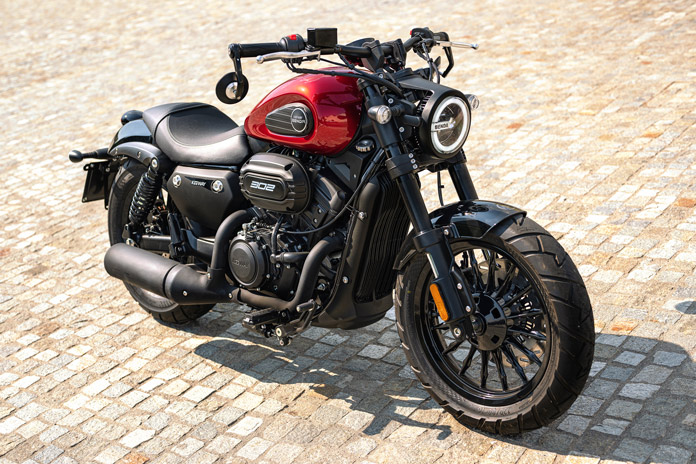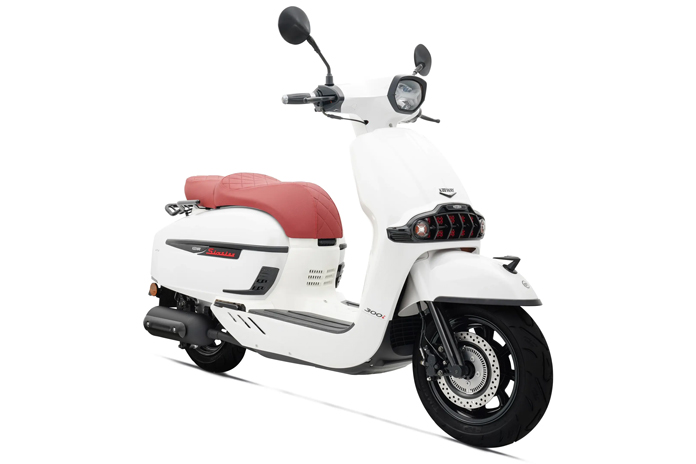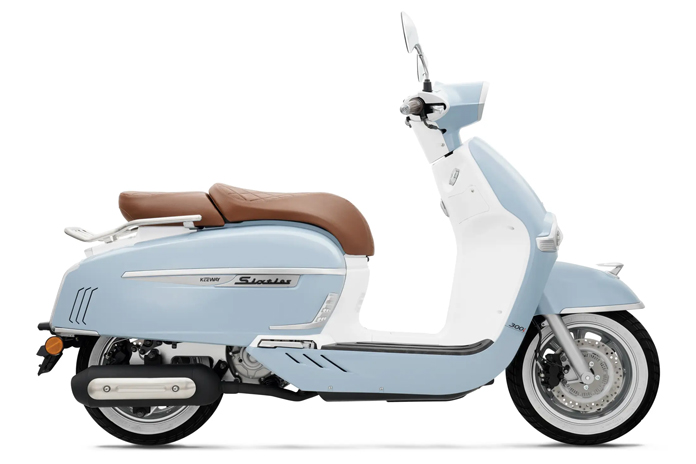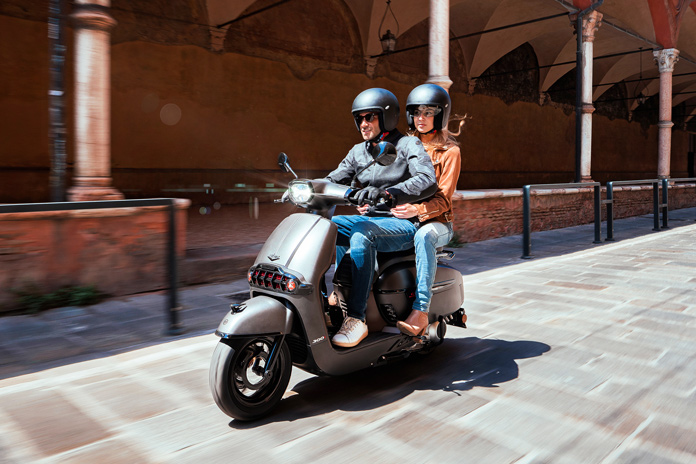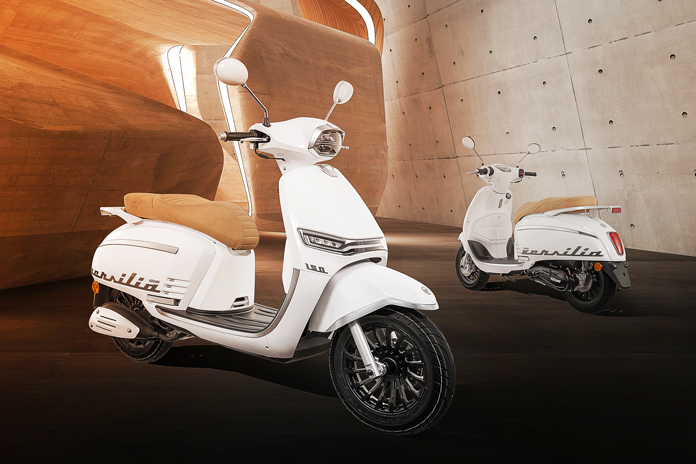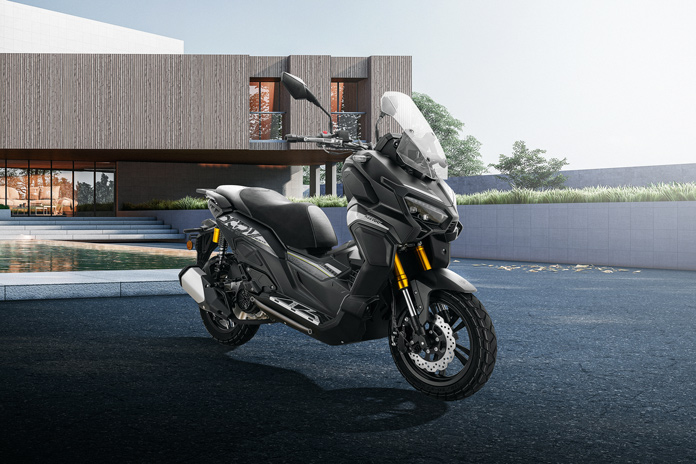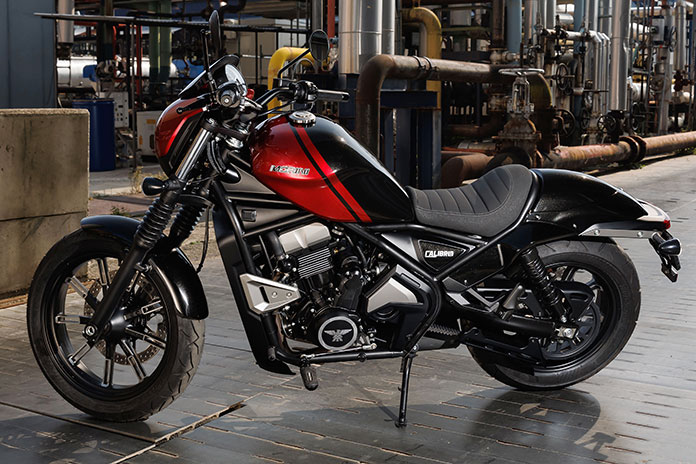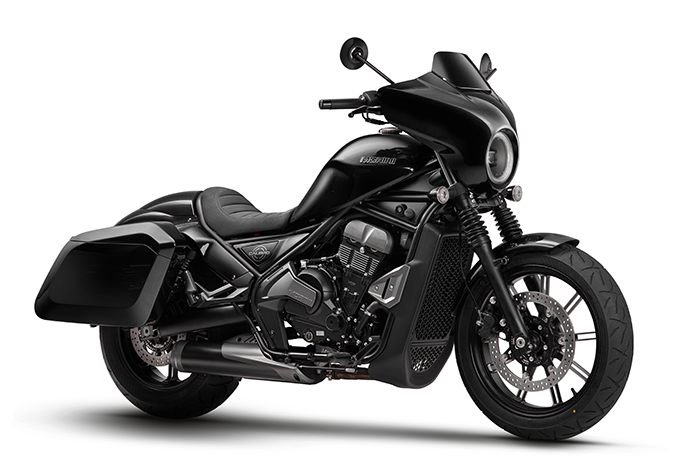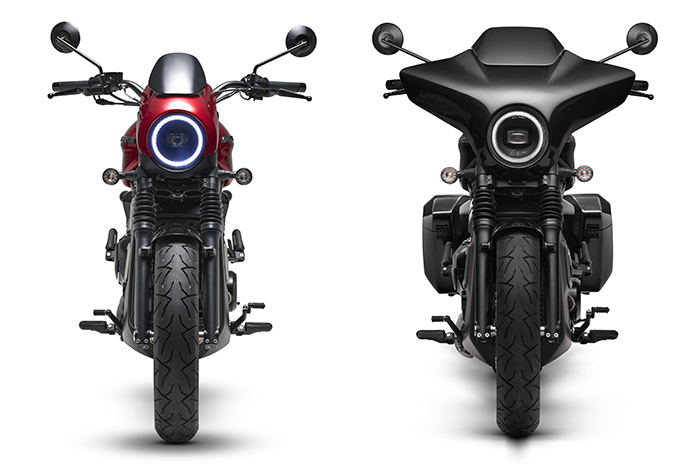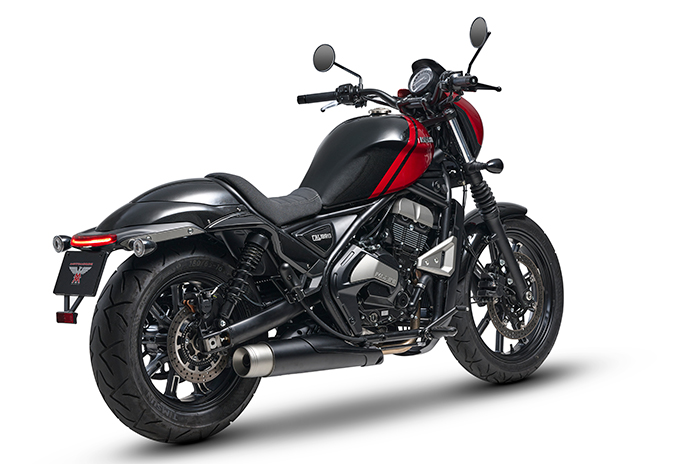The post 2025 Indian Scout Review | Video appeared first on Rider Magazine.
]]>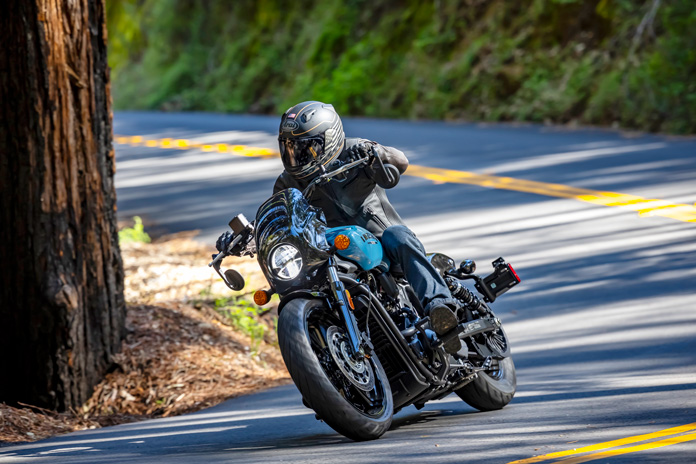
The Indian Scout lineup has been redesigned for model year 2025, ushering in a new generation of Indian Motorcycle’s best-selling platform. The lineup includes five distinct models, all featuring the new SpeedPlus 1250 V-Twin, a new tubular-steel frame, and other changes.
We got the chance to test all five models and came away impressed. Take a ride with us in the video below as we review the trimmed-down Scout Bobber, the traditional Scout Classic, the light-touring Super Scout, the spirited Sport Scout, and the top-of-the-line 101 Scout. Read our full review here.
2025 Indian Scout Specifications
- Base Price: $12,999 (Bobber); $13,499 (Sport Scout); $13,999 (Classic); $16,499 (Super Scout); $16,999 (101 Scout)
- Website: IndianMotorcycle.com
- Warranty: 2 yrs., unltd. miles
- Engine Type: Liquid-cooled, transverse V-Twin, DOHC w/ 4 valves per cyl.
- Displacement: 1,250cc
- Bore x Stroke: 104 x 73.6mm
- Horsepower: 105 hp (111 hp on 101 Scout) @ 7,250 rpm (factory claim)
- Torque: 82 lb-ft @ 6,300 rpm (factory claim)
- Transmission: 6-speed, cable-actuated slip/assist wet clutch
- Final Drive: Belt
- Wheelbase: 61.5 in.
- Rake/Trail: 29 degrees/4.8 in.
- Seat Height: 25.6 in.
- Wet Weight: 542 lb (Bobber); 548 lb (Sport Scout); 549 lb (101 Scout); 555 lb (Scout Classic); 589 lb (Super Scout)
- Fuel Capacity: 3.4 gal.
Gear Up
- Helmet: Arai Signet-X
- Jacket: Alpinestars Hoxton V2
- Airbag Vest: Alpinestars Tech-Air 3
- Gloves: Alpinestars Phenom
- Pants: Roadskin Elite
- Boots: Highway 21 Journeyman
The post 2025 Indian Scout Review | Video appeared first on Rider Magazine.
]]>The post 2025 Indian Scout Review | First Ride appeared first on Rider Magazine.
]]>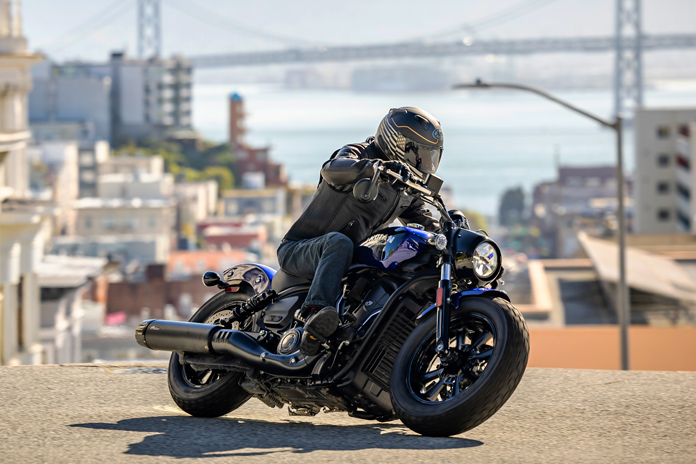
The Scout is incredibly important to Indian Motorcycle. It’s the brand’s top‑selling platform, with more than 110,000 sold since its 2015 debut. It comprises more than 40% of Indian’s total sales volume and more than 50% of its international sales. And, crucially, it’s the entry point for Indian, with 93% of Scout customers being new to the brand.
So when Indian decided to give the Scout a full make‑over treatment, it wanted to avoid screwing up a successful formula. No surprise, then, that evolution of the Scout was a better approach than revolution.
“We needed to make sure we didn’t mess it up,” explained Ben Lindaman, product director for the Scout platform. “People love it, so that’s what made the development process challenging.”
That said, the Scout’s new frame goes far beyond evolution. The former cast‑aluminum frame was cast aside for a tubular‑steel design, similar to what was done to the Chief platform in 2021. Chassis geometry remains similar, with a 29‑degree rake, 4.8 inches of trail, and wheels spread 61.5 inches apart.
Related: West Coast Cruiser Motorcycle Battle: Harley-Davidson Low Rider S vs. Indian Sport Chief
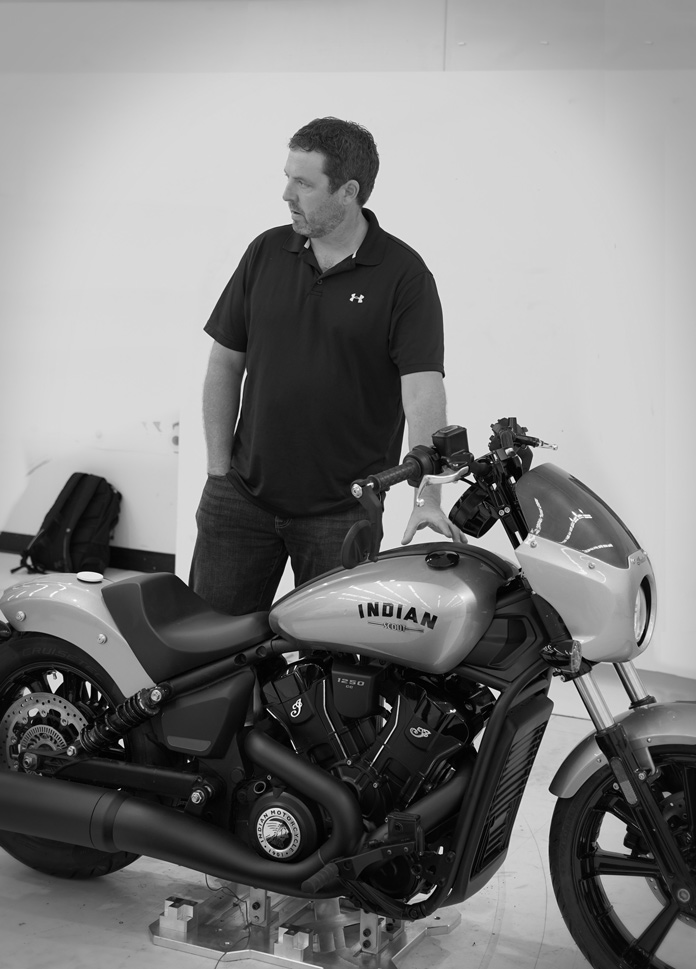
The Scout’s new frame, while seemingly backward in technology, provides a much cleaner chassis design than the bulkier aluminum structure that looked blocky and awkward in the area behind the front wheel. Surprisingly, Indian says the weight of the steel frame is similar to the former aluminum one.
Ola Stenegard, Indian’s director of industrial design, explained the guiding principles of the Scout redesign: timeless; keep it simple and clean; customizing is key.
Stenegard noted how the “S” line from the steering neck to the frame’s downtubes was patterned after the original Scout, which debuted in 1920, as well as even earlier Indians. And by using a steel frame, the modification process for custom builders was simplified: “Customizing is the cornerstone of what we’re doing,” he said.
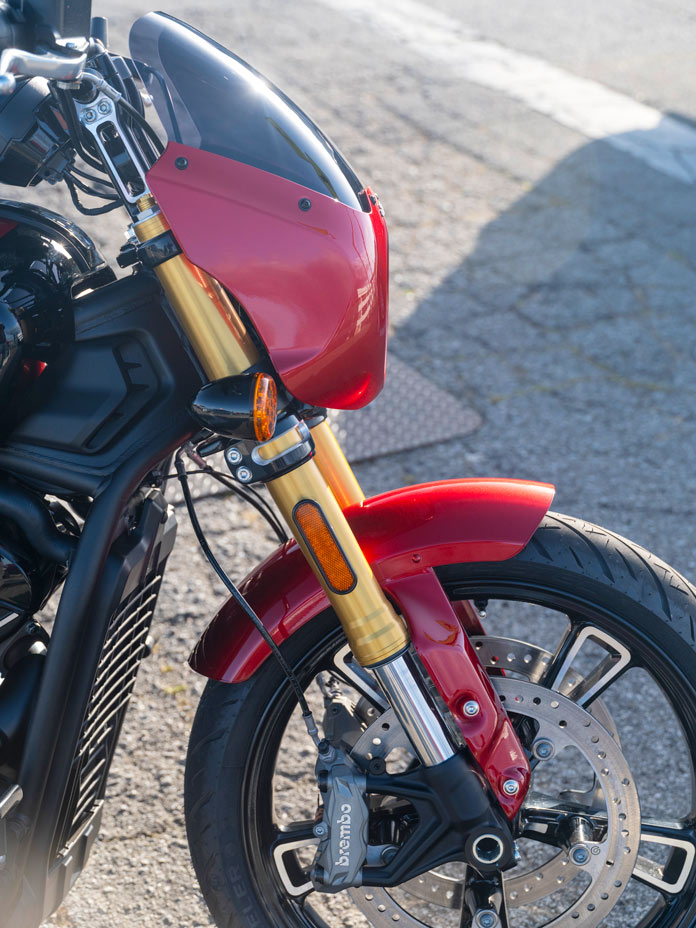
Some of the best design work is invisible. The subframe area below the seat remains aluminum, but it’s a new casting that now encloses most of the Scout’s electronics and supports the modular electrical system. This enables shorter wiring and prevents components from being scattered around the motorcycle, resulting in a cleaner overall appearance.
The subframe casting also ties together the chassis behind the engine for optimum rigidity, and it’s now common among all Scout models. So instead of model‑specific seat pans and bracketry, all Scout seats and fenders can be used across the platform, simplifying things for customers, dealers, and the aftermarket.
Less revolutionary is the Scout’s rolling stock, with wheels, brakes, and suspension largely carried over from previous Scouts. Indian says the Scout’s 25.6‑inch seat height is the lowest in its class. Tank‑empty weights range from 522 lb (Bobber) to 571 lb (Super Scout).
All five models are equipped with antilock brakes, full LED lighting, and self‑canceling turnsignals. Versions with analog gauges now include fuel level and fuel economy readouts.
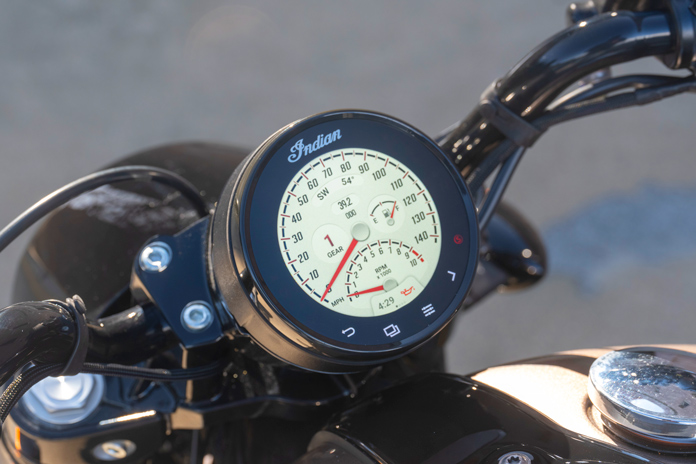
To further expand customer choice, the Scout is available with different trim levels. The Limited package adds cruise control, traction control, selectable ride modes (Sport, Standard, and Tour), and a USB charging port for an extra $700.
More features are included in the $1,700 Limited +Tech trim level, which adds keyless ignition and Indian’s 4‑inch round touchscreen TFT instrumentation. Thus equipped, riders can access navigation and additional ride info, plus it can be configured to view alternate layouts. It’s standard on the Super Scout and 101 Scout.
Indian Scout SpeedPlus 1250: Engine & Tonic
The Scout’s liquid‑cooled 60‑degree V‑Twin received a comprehensive overhaul. At first glance, the SpeedPlus 1250 appears to be just a simple overbore, punching out the cylinders from 99mm to 104mm and retaining its 73.6mm stroke to displace 1,250cc (76.3ci), up from the previous 1,133cc.
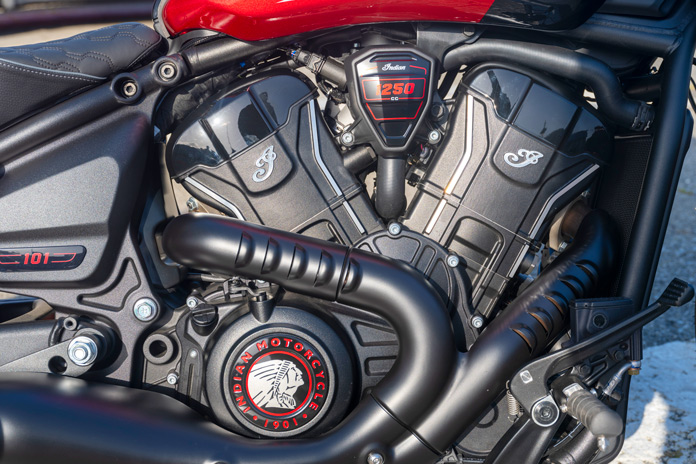
However, there are myriad internal changes for the SpeedPlus – Indian says it’s at least 70% new. A fresh cylinder‑head design ups the compression ratio and contains bigger valves operated by new camshaft profiles. At the bottom end, the crankshaft is 5.8 lb lighter, contributing to the motor’s significant 10‑lb weight loss. Importantly for servicing access, the valve covers can now be removed without splitting the frame, and checking oil levels is made simpler with a new sight‑glass window.
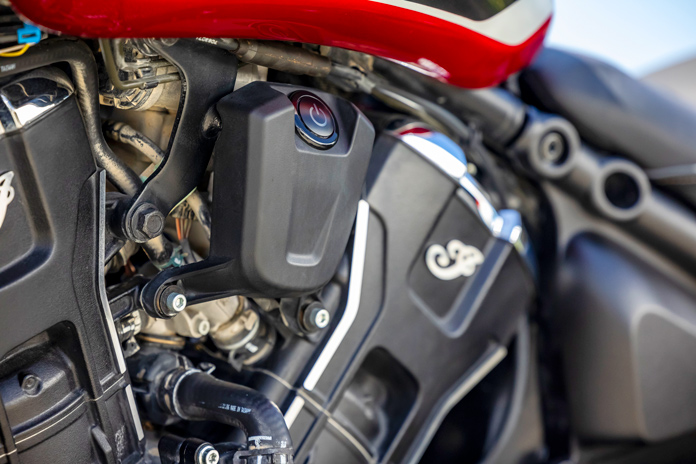
The old 2‑into‑2 exhaust system has been ditched in favor of a single large muffler. It looks bulkier, but it’s designed to be much easier to replace with aftermarket systems. The bike’s catalytic converters are contained in the junction prior to the muffler, so a simple swap to a slip‑on exhaust retains clean emissions even if noise might exceed regulations.
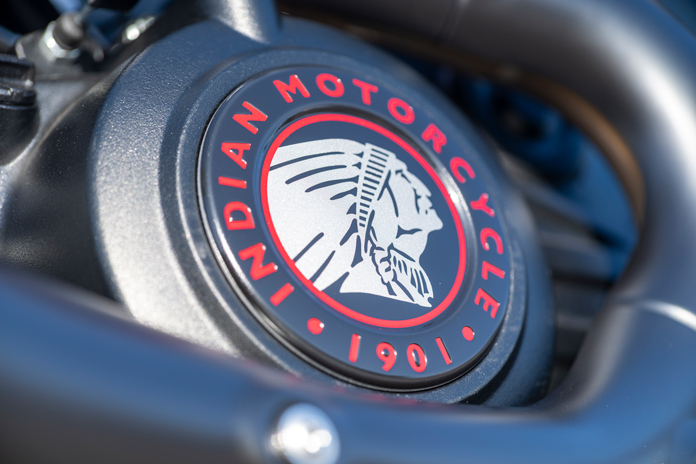
Horsepower has been boosted from 100 to 105 hp. More important to regular riding duties is the engine’s 14% torque bump, jumping from 72 to 82 lb‑ft. Torque reaches its peak at 6,300 rpm, while peak ponies arrive at 7,250 revs, long before the 8,500‑rpm rev limiter kicks in. The 101 Scout has special electronic tuning that nudges its peak output to 111 hp, a tune that other Scouts can get via a dealer reflash for $219.99.
Transmission duties are handled by a new slip/assist clutch that reduces lever effort and prevents rear‑wheel hopping during sloppy downshifts. The engine’s drive sprocket has its tooth count reduced by one, yielding slightly shorter overall gearing for punchier acceleration.
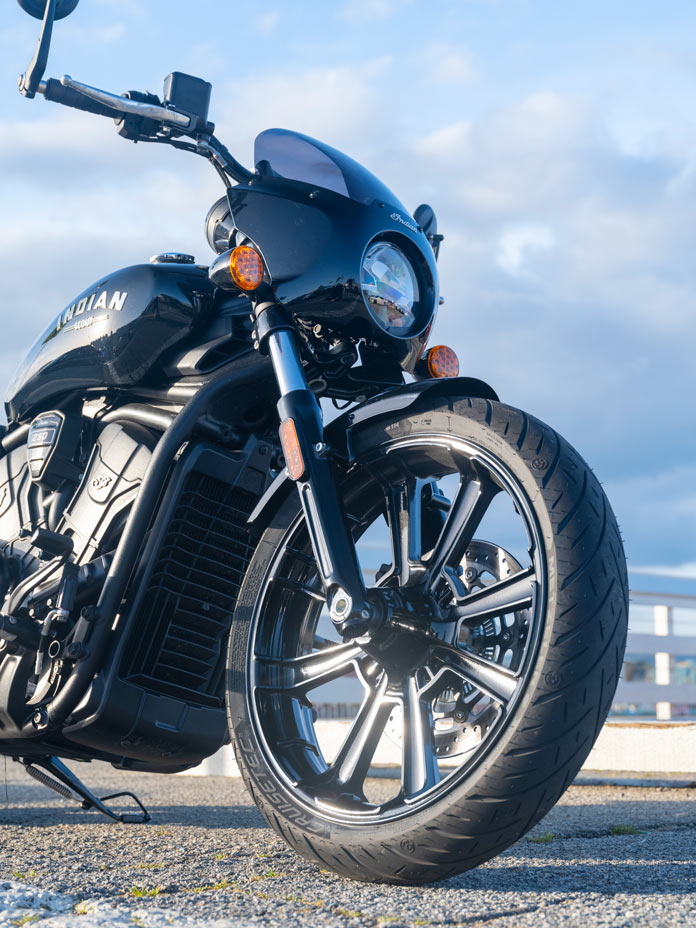
Indian Scout Test Rides
Now it’s time for the fun part of motorcycle journalism – riding the new bikes! We set off on the Bobber, Classic, and Super Scouts for a trip through San Francisco and then south to oceanside Santa Cruz for an overnighter.
Read all of Rider‘s Indian Motorcycle reviews here.
The next day, we took a return journey along twisty roads on the Sport Scout before a stop at the famous motorcycle hangout Alice’s Restaurant. After a quick lunch, we mounted up on the headliner of the platform, the 101 Scout, and tore up some more twisty roads before jumping on the freeway for our return to San Fran.
Indian Scout Bobber: The Rebel
The Bobber looks imposing with its fat front tire, low handlebar, and blacked‑out trim, so it’s easy to see why it has been the Scout’s best‑selling model. Its appearance is augmented by short‑cropped fenders for an aggressive look, and its headlight is capped with a minimalistic nacelle.
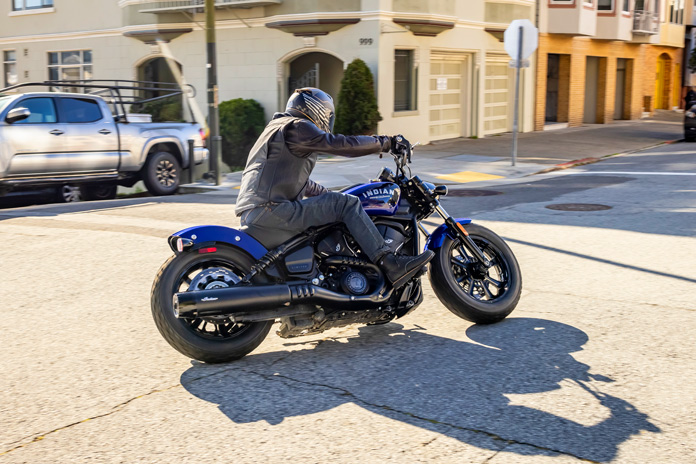
Our test bike was equipped with the Limited +Tech package, so no key was needed to fire it up. The 60‑degree V‑Twin sounds deep and authoritative, but it lacks the loping cadence of narrower vee angle motors like Indian’s Chief and most Harleys.
The new slip/assist clutch in the Scouts is an impressive upgrade. Pulling in the lever is an action repeated hundreds of times during a ride, and the Scout’s requires only minimal effort. Additionally, its slipper function kept the rear wheel turning even when dumped at obscenely aggressive revs during downshifts.
Once underway, the Bobber feels similar to the previous version, as its weight and geometry have barely changed, and its suspension, brakes, and tires haven’t at all. While I appreciate the butch look of the chunky Pirelli MT60RS tires, the tall sidewall of the 130/90‑16 front tire attenuates front‑end feedback.
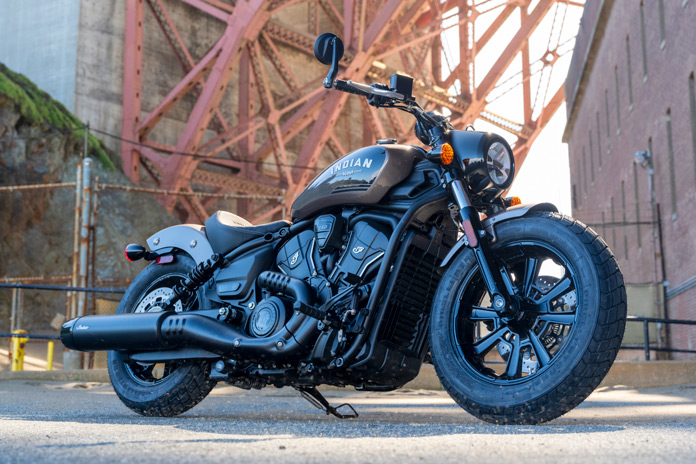
The underslung bar‑end mirrors were out of eyeshot without looking downward, and they’re in danger of scuffing the fuel tank at full lock. Happily, they can be easily switched to locations above the handlebar by swapping sides. Either way, you’ll be looking at empty perches above the bars where mirrors are mounted on the Classic and Super Scouts.
Riding through town didn’t allow for delving deep into the powerband, but the SpeedPlus impressed with its beefier reactions to small throttle inputs. The Scout now has the mid‑rpm juice to feel like it has even more than 76ci at its disposal.
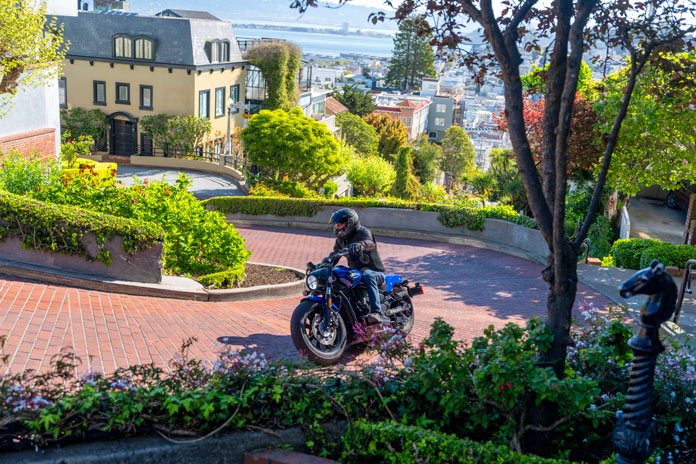
The fuel‑injection tuning was mostly good, but some of our pre‑production bikes occasionally stalled while mired in traffic. Indian promises a more finely tuned EFI map in its production models. Otherwise, throttle response was excellent.
The Bobber is a fun ride, but it comes up short – literally – in terms of rear‑suspension compliance. To achieve its low‑slung look, it is fitted with shocks that deliver just 2 inches of travel; every other Scout model has 3 inches of stroke. It’s true what some say: Even 1 inch can make a big difference in performance.
Indian Scout Classic: The Traditional One
If you’re a rider who hasn’t yet warmed to dull colors and matte‑black trim, turn your head toward the Scout Classic. Instead of the Bobber’s tough‑looking colorways, the Classic responds with brighter paintwork and plenty of chrome accents. Full fenders – rather than bobbed ones – are gracefully old‑school. Prices start at $13,999.
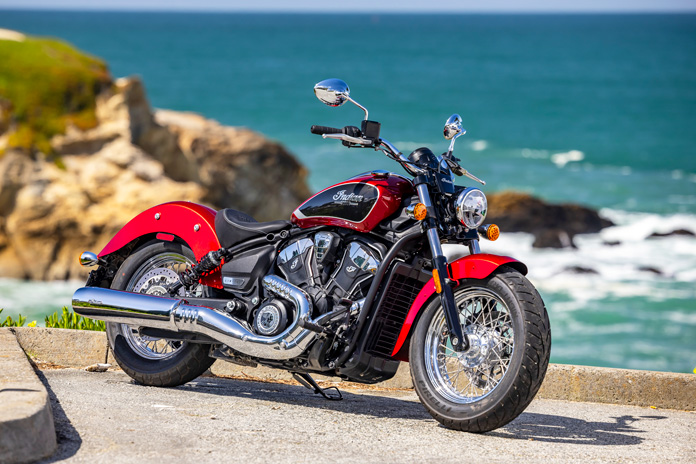
Both bikes use 16‑inch front and rear wheels, but the Scout Classic substitutes 40‑spoke wire wheels for the Bobber’s cast‑aluminum hoops. And rather than the dirt‑track‑inspired Dunlops on the Bobber, the Classic is fitted with Pirelli Night Dragon tires that proved to be more responsive and easier to steer.
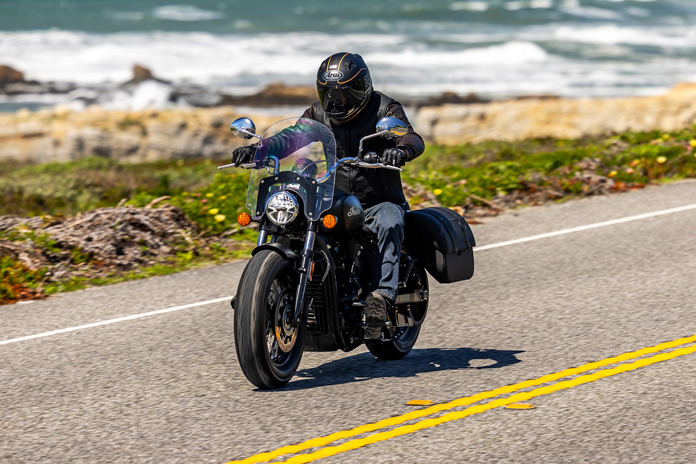
I found the riding position of the Classic preferable over the more compact arrangement on the Bobber. Its bars are placed higher, which makes the bike slightly easier to steer and maneuver in tighter spaces at low speeds.
The Scout Classic (and every other Scout) proved that 3 inches of travel is considerably better than the 2 inches on the Bobber. Meanwhile, the SpeedPlus drivetrain continued to impress, and for some reason, the engine never died on me like the Bobber’s.
Indian Super Scout: The Versatile One
The Super Scout takes its inspiration from the Super Chief, as they’re both equipped with a windshield, saddlebags, and a passenger seat to make them suitable for two‑up travel. And on a warm day the windshield quickly detaches for wind‑in‑the‑face riding.
Like the Scout Classic, it has chrome finishes, longer fenders, a higher handlebar, and wire‑spoke wheels. And that appreciable extra inch. All that adds up to the heaviest Scout model, scaling in at 571 lb. Prices start at $16,499.
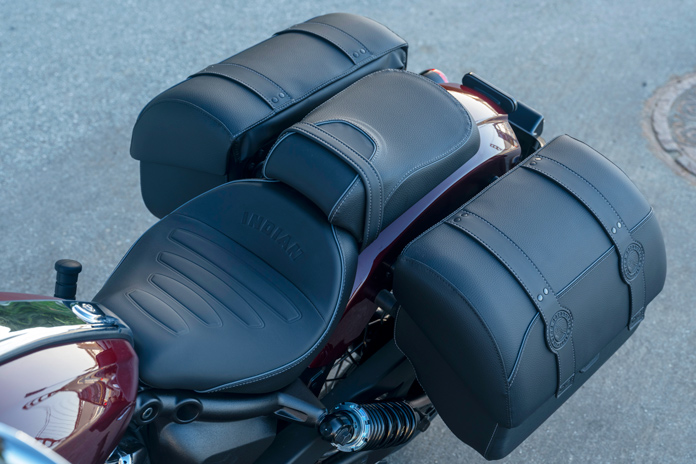
The handlebar placement felt neutral to my hands, and the seat felt good to my…seat. Chrome mirrors on perches aren’t my style, but they kept my rearward view unobstructed. The Super Scout’s windshield produced more noise than the accessory shield fitted to the Scout Classic I rode.
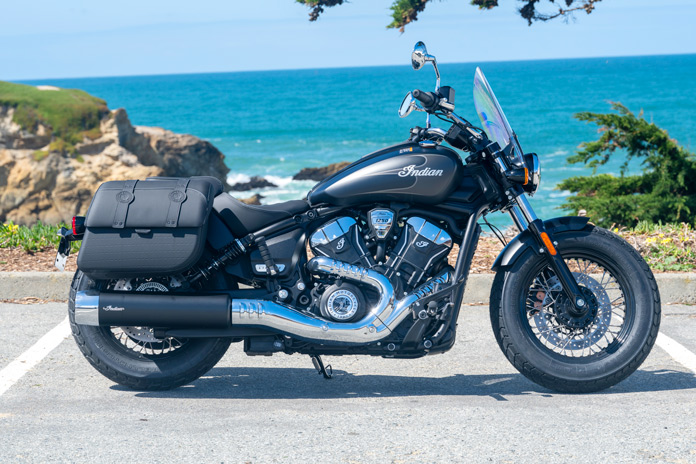
Like the Bobber, the Super rolls on the same chunky Pirelli MT60RS rubber, and again I didn’t warm to their duller responses as compared to the Night Dragons. Also feedback from the brakes was dull, the front in particular. While braided‑steel lines provide a firm lever, the Scout’s brakes are average at best.
Indian Sport Scout: Going Rogue
Remember the Scout Rogue introduced in 2022 (see our June issue), which was equipped with a quarter fairing, drop‑down mirrors, and a 19‑inch cast‑aluminum front wheel? Well, that formula can be found in the new Sport Scout, which reprises an Indian model name from the 1930s.

This new model also receives different ergonomics. Machined triple‑clamps fitted with 6‑inch risers and a moto‑style handlebar put riders in an aggressive posture. A sport‑style seat has a taller rear section to keep riders aboard when accessing the strong power available from the SpeedPlus.
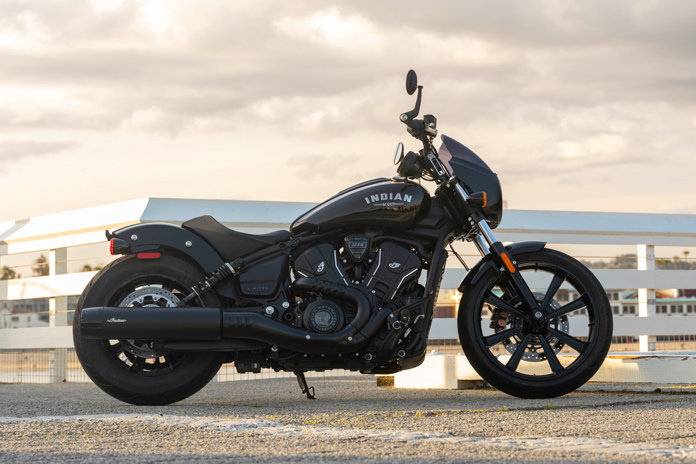
On the road, the engine and transmission feel well‑suited to the Sport Scout. Although down on ponies compared to the 121 hp of Harley‑Davidson’s RevMax in the Sportster S, the Indian motor generates more vibration and exhibits a character more in line with a cruiser.
The Sport Scout’s best asset is the neutral steering feel provided by the 130/60‑19 Metzeler Cruisetech front tire. Going to a shorter‑profile tire enhances the feedback felt at the bars, and this arrangement was preferable over the chunky 16‑incher on some other Scouts.
GEAR UP
- Helmet: Arai Signet-X
- Jacket: Alpinestars Hoxton V2
- Airbag Vest: Alpinestars Tech-Air 3
- Gloves: Alpinestars Phenom
- Pants: Roadskin Elite
- Boots: Highway 21 Journeyman
With prices starting at $13,499, the Sport Scout has the potential to topple the Bobber from the top of the sales charts – it would be my target if walking into an Indian dealership. Sure, its quarter fairing provides more style than wind protection, and I’d have to dig out extra dollars for the extra tech features I’d want to have, but it has the best capabilities‑per‑dollar ratio of any American motorcycle.
Indian 101 Scout: A Legend Reborn
The 101 Scout is perhaps the most revered Indian motorcycle ever made, so reviving the historic nameplate wasn’t taken lightly. With a special tune claimed to deliver 111 hp, the result is the highest‑performing Scout to date.
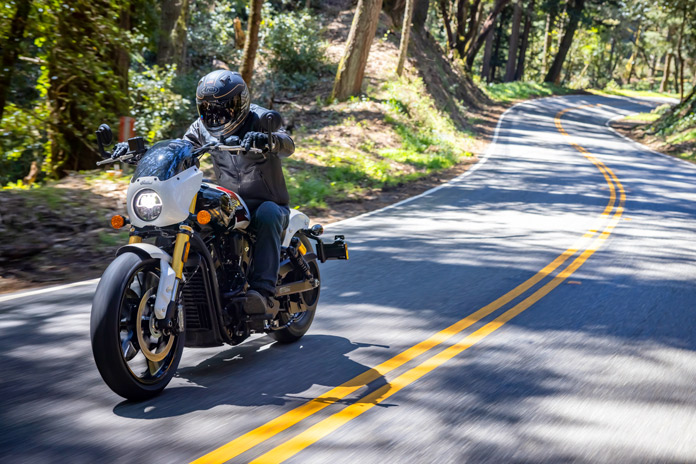
In a nutshell, the 101 Scout is a Sport Scout with the front end of an Indian FTR bolted on. That not only brings the security of an inverted fork with a full range of adjustability, but also a front‑brake setup that shames the capabilities of the other Scouts. Instead of a single disc with a 2‑piston caliper, the 101 has dual 320mm discs bitten by a pair of 4‑piston Brembo radial‑mount calipers. The increase in power and feedback is astonishing.
Like the Sport Scout, it has black 6‑inch risers with machined highlights and a moto‑style handlebar, providing purposefully aggressive ergonomics. Unlike other Scouts, the 101 has piggyback shocks that are adjustable for preload and rebound/compression damping. It also sets itself apart with a custom‑stitched gunfighter‑style solo seat and exclusive 101 Scout badging, paint, and graphics.
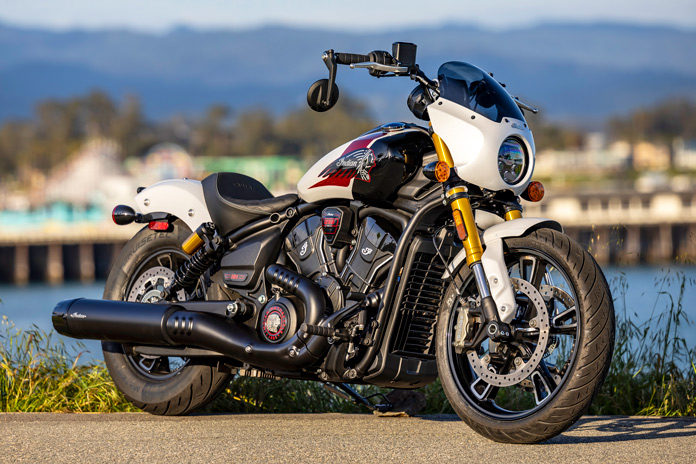
I wish I could tell you that the 101’s engine tuning felt much more powerful compared to its lesser siblings, but the difference is felt only at the top of the rev range, a zone rarely accessed on public roads. I couldn’t tell the difference when riding at casual revs.
There is a more notable improvement with the 101’s suspension, especially at the rear end. The fully adjustable shocks provided extra control, and bump absorption got even better after I dialed up their rebound damping via the hand‑adjustable clickers.
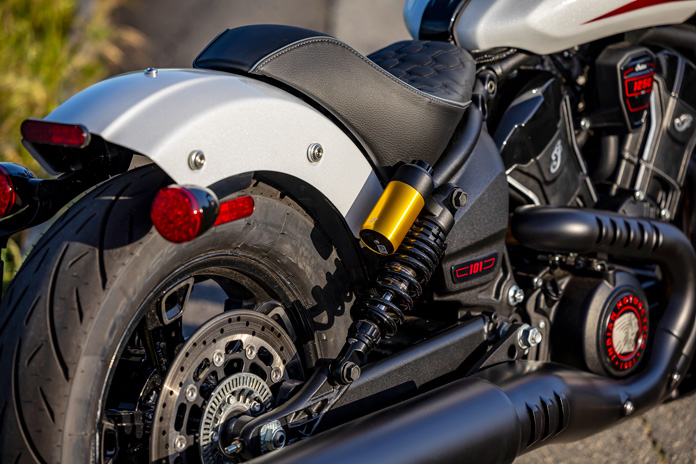
The only negative to the 101 Scout is that the extra brake caliper and rotor adds weight to the front wheel, causing the bike to steer slower than its brethren and feel slightly less agile. I believe a single‑rotor Brembo setup would provide significantly improved braking performance relative to the other Scouts, but Indian contends that customers for a bike like this demand dual discs.
Indian’s goal with the 101 Scout was to reset the bar for American V‑Twin cruisers, and it succeeded. It offers more performance than any production Scout, and it does so with unrivaled capability and style.
Talent Scout
If you’re gonna proudly yell “Made in America” when buying a mid‑size cruiser, your choices are limited. Indian makes a solid case for itself with these new Scouts, and it intends to become the market‑share leader in the segment. After riding the new Scouts, that seems likely.
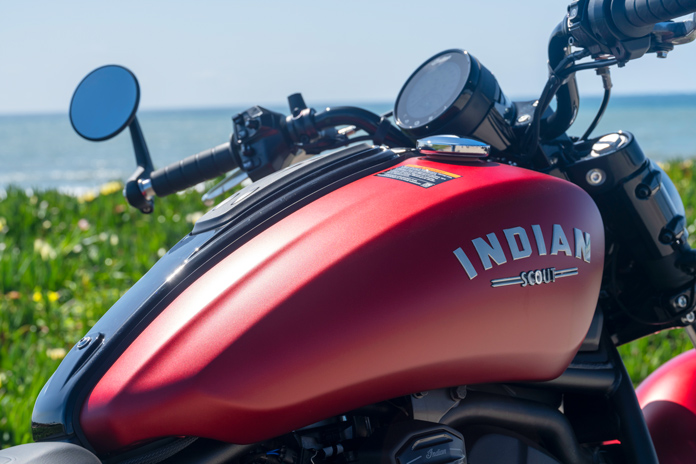
Harley‑Davidson’s 975cc Nightster has a starting price of $13,499, $500 more than the Scout Bobber. But with 91 hp and 72 lb‑ft of torque, it’s significantly down on power. The MoCo’s Sportster S has 10 extra horses over the 101 Scout and is priced identically, but its 2 inches of rear suspension travel comes up short – there’s that extra inch again.
The new Scouts improve on the previous admirable Scouts in every important aspect: performance, style, execution, and desirability. Lindaman, the Scout’s product director, said this redesign should extend the Scout platform for another 10‑year run.
Somewhere along the line I’d like to see a cheaper version of the 101 Scout with a single‑disc Brembo brake setup and a pair of shocks with 4 inches of travel, which I was told would fit without further modifications. Until then, I’d be thrilled with a (very) long‑term 101 Scout loaner.
Check out more new bikes in Rider’s 2024 Motorcycle Buyers Guide
2025 Indian Scout Specs
- Base Price: $12,999 (Bobber); $13,499 (Sport Scout); $13,999 (Classic); $16,499 (Super Scout); $16,999 (101 Scout)
- Website: IndianMotorcycle.com
- Warranty: 2 yrs., unltd. miles
- Engine Type: Liquid-cooled, transverse V-Twin, DOHC w/ 4 valves per cyl.
- Displacement: 1,250cc
- Bore x Stroke: 104 x 73.6mm
- Horsepower: 105 hp (111 hp on 101 Scout) @ 7,250 rpm (factory claim)
- Torque: 82 lb-ft @ 6,300 rpm (factory claim)
- Transmission: 6-speed, cable-actuated slip/assist wet clutch
- Final Drive: Belt
- Wheelbase: 61.5 in.
- Rake/Trail: 29 degrees/4.8 in.
- Seat Height: 25.6 in.
- Wet Weight: 542 lb (Bobber); 548 lb (Sport Scout); 549 lb (101 Scout); 555 lb (Scout Classic); 589 lb (Super Scout)
- Fuel Capacity: 3.4 gal.
The post 2025 Indian Scout Review | First Ride appeared first on Rider Magazine.
]]>The post 2023 Honda Rebel 1100T DCT Review | Ridden & Rated appeared first on Rider Magazine.
]]>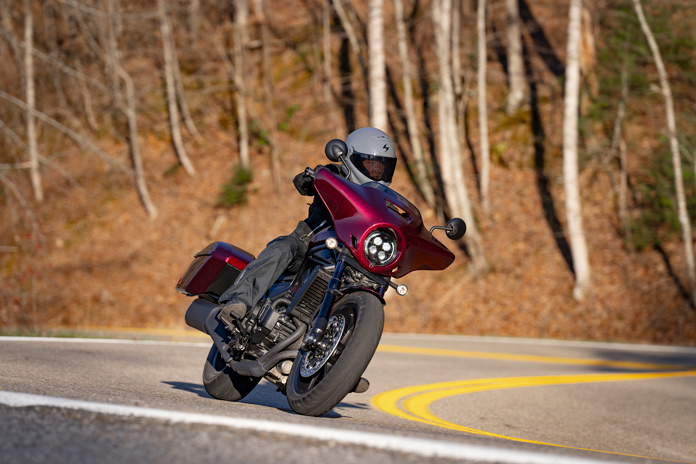
Many motorcyclists – including me – got their start on a Honda Rebel, and they need not jump ship once they’re ready for something with more kick. Honda’s lineup of Rebels includes the 300, 500, and 1100, providing a ladder for riders to climb when they get the itch for something bigger. The lineup expanded last year with the addition of the Rebel 1100T DCT, a bagger-style cruiser.
Related: A Girl and Her Honda Rebel
The “T” in “1100T” stands for “touring,” and added features include a batwing fairing and saddlebags with a combined 35 liters of storage – not enough room to carry all your belongings but enough for clothes and personal items for a few days. The fairing includes a short windscreen, and taller or shorter windscreens are available as options. In standard trim, the Rebel 1100 is set up for a solo rider, but a passenger seat and footpegs are available. The 2023 test bike used for this review is Bordeaux Red Metallic; for 2024, color options include Metallic Black and Matte Armored Green Metallic.
Related: 2024 Honda Gold Wing, Rebel, and NC750X Returning Models
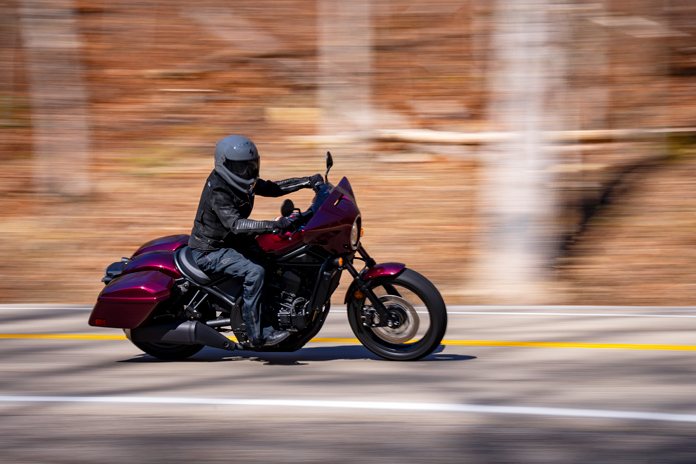
GEAR UP
- Helmet: Scorpion EXO Covert FX
- Jacket: Joe Rocket Wicked
- Gloves: Joe Rocket Ballistic
- Pants: Fly Racing Butane Overpants
- Boots: Highway 21 Axle Leather Waterproof
The Rebel 1100 came on the scene in 2021. It’s powered by the liquid-cooled 1,083cc Unicam parallel-Twin from the Africa Twin but modified for a cruiser application. At 87 hp and 72 lb-ft of torque, the Rebel 1100 makes less power than the Africa Twin, but peak torque arrives earlier in the rev range (4,750 rpm vs. 6,250 rpm). The engine has a 270-degree crankshaft for a rumbling V-Twin-like character, and the Rebel uses different camshaft profiles and ignition timing for its two cylinders – one makes more power below 4,000 rpm, and the other makes more power above 4,000 rpm. It comes with four ride modes (Rain, Sport, Tour, and User, which is customizable), each with different settings for throttle response, traction control, engine braking, and (on DCT versions) the transmission’s shift points.
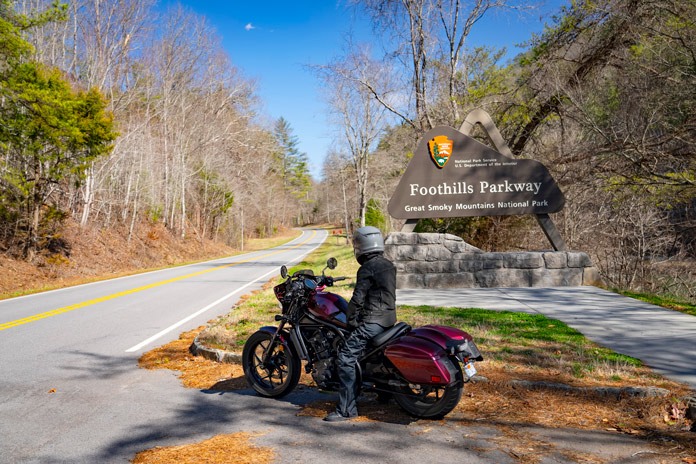
As with several models in Honda’s lineup, the Rebel 1100 is available with either a 6-speed manual gearbox or a 6-speed automatic Dual Clutch Transmission. The DCT is a popular option, accounting for about half of sales for models on which it’s available, including the Africa Twin, Gold Wing, and NC750X. With DCT, there is no clutch lever or foot shifter. Just release the parking brake, click the bike into Drive, and ride. Riders who want more control can switch to Manual mode and use the paddle shifters on the left side of the handlebar to click through gears. For 2024, the Rebel 1100T is available in either a manual or DCT option.
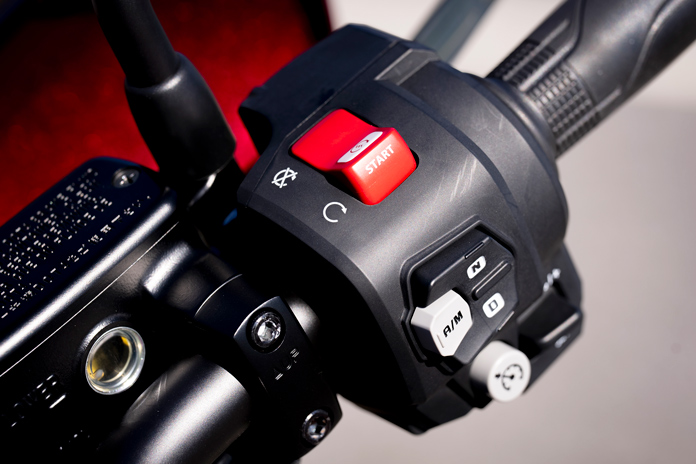
This test was my first experience with Honda’s DCT, and I shared the same concerns as others – that an automatic motorcycle would feel strange and take away from the riding experience. It does take some time to get used to, but after more than 1,000 miles aboard the Rebel 1100T DCT, I see the merit and came to enjoy the transmission.
The beauty of the DCT is that it allows the rider to spend more time focusing on the ride and less time worrying about shifting gears. There’s no need to shift up and down while rolling through town, which means you can pay closer attention to traffic, and your left hand won’t get tired of pulling in the clutch lever. When you head out for a more scenic ride, you have more time to admire the view. And when you get into the twisties and desire more control, you can click the bike into Manual mode and shift with the paddle shifters.
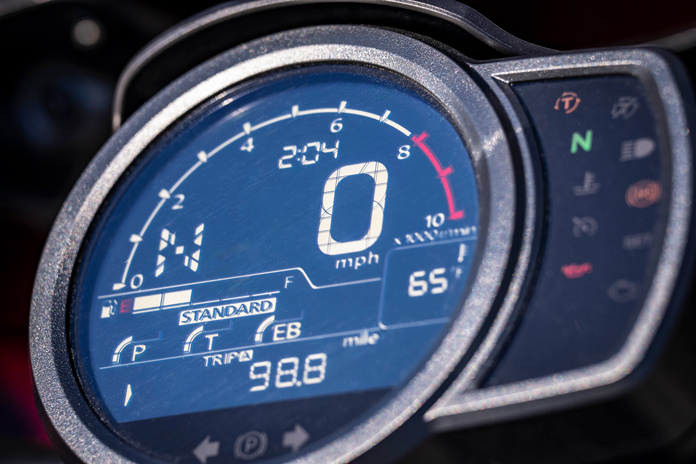
In each of the Rebel’s four ride modes, the round LCD display shows settings for power, traction control, and engine braking, and these parameters can be adjusted in the user-configurable mode. While in Automatic mode, the shift points parameter also shows. I enjoyed the visual representation of how each mode changed the riding experience on the display, and it made it easier to set my preferred parameters. Additional features include cruise control and a USB-C charging port located under the seat.
When riding a motorcycle with a manual transmission, I leave the bike in gear when parked. That’s not possible on the Rebel 1100T DCT, as it always switches to neutral when turned off. To keep it from rolling away, there’s a parking brake lever on the left side of the handlebar. Setting the parking brake is easy enough, but I found releasing it to be a bit difficult, which involves pulling back on the lever while pushing a button on the side, requiring two hands. This means that there are no hands on the handlebar when the brake is released, so I needed to keep my right foot on the rear brake pedal to prevent the bike from rolling when stopped on an incline. This requires a bit of learning, but it wasn’t a problem once I became used to it.
Suspension duties are handled by Showa components, with a 43mm nonadjustable fork with 4.8 inches of travel and a pair of rear shocks with adjustable preload, piggyback reservoirs, and 3.7 inches of travel. Stopping power comes from a single radial-mount 4-piston front caliper with a 330mm disc and a 1-piston rear caliper with a 256mm disc. ABS is standard, and though few riders may need it, the Selectable Torque Control system (Honda’s term for traction control) includes three levels of wheelie control.
With high, mid-mount footpegs, the Rebel 1100 has an impressive lean angle of 35 degrees. The wheelbase is 59.8 inches, wet weight is 520 lb, and fuel capacity is 3.6 gallons. Honda could’ve added more touring capability to this bike with a larger fuel tank. During this test, the low-fuel light came on whenever the tripmeter reached about 110 miles, and I averaged 46.4 mpg (about 167 miles of range).
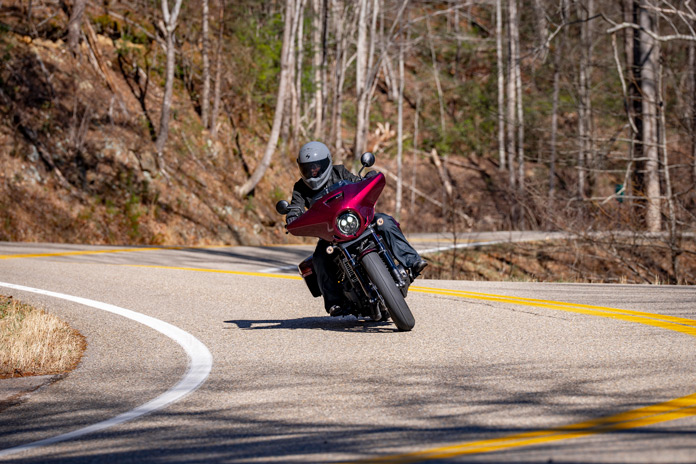
Seat height has always been approachable on Rebels, and that holds true on the 1100, which has a very low seat height of 27.5 inches. As a short rider (5-foot-1), I appreciate being able to flat-foot on a motorcycle. However, the Rebel 1100T’s footpeg position requires the rider to sit somewhat scrunched up on the bike. The seating position puts pressure on the rider’s spine, which became uncomfortable after a few hours in the saddle. Although I didn’t expect Gold Wing levels of comfort, a bagger-style cruiser like this would benefit from a more comfortable riding position. However, after a quick break at a scenic overlook or gas station, I was ready to hop back into the saddle.
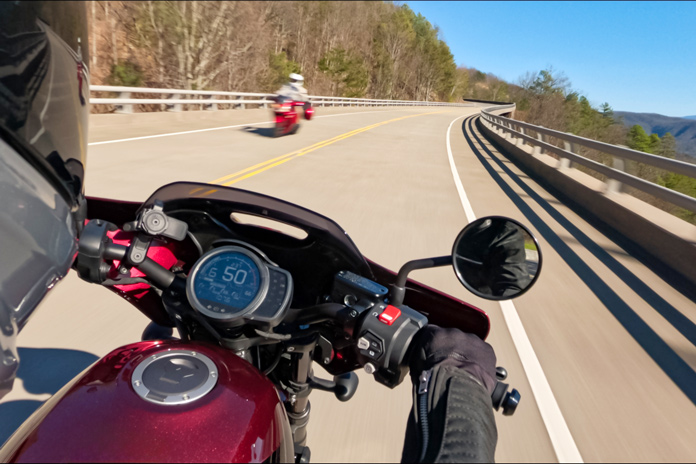
Although I found the riding position uncomfortable for long hours, the Rebel 1100T DCT is an absolute blast to ride on twisty roads. Its low weight and responsive handling make the bike easy to dip into corners, and the engine pulls strongly when accelerating out of turns. On particularly technical roads, I enjoyed switching the bike into Manual mode and clicking through gears with the paddle shifters, which offers a more simplified experience without needing to pull in the clutch or roll off the throttle, making gear changes quicker and easier.
The Rebel 1100T’s fairing and saddlebags are the only differences between this model and the standard version, but those extras create a package that’s more practical for overnight trips. The fairing provides good wind protection and blocks wind from the chest and hands. The saddlebags add enough storage that I could pack everything I needed for a couple nights. My only complaint about the bags is that the latching mechanism is a little finicky and takes some effort to close. The top-loading bags are lockable, or they can be left unlocked for quick access.
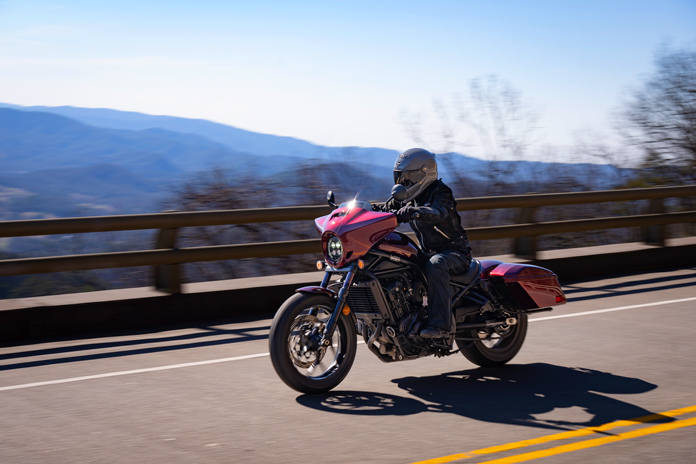
The trim on the Rebel 1100T might not be enough to turn it into a full-fledged long-haul touring bike, but it’s a useful addition for the type of trips I like to do, which are two or three days with minimal luggage. The bags allow me to pack my clothes and necessities without needing to wear a backpack, and the fairing provides enough protection to keep me comfortable for longer periods of time.
On top of the Rebel’s practicality, its sporty engine, good cornering clearance, and low weight means that once I get near my destination, I can enjoy the roads in a way that a heavier bagger wouldn’t allow. As far as compromises go, this one strikes the balance to suit my needs just fine. And with the Dual Clutch Transmission, I can focus less on shifting gears and more on the ride.
2023 Honda Rebel 1100T DCT Specifications
- Base Price: $11,299 ($11,349 in 2024)
- Warranty: 1 yr., unltd. miles
- Website: Powersports.Honda.com
- Engine Type: Liquid-cooled, transverse parallel-Twin, SOHC w/ 4 valves per cyl.
- Displacement: 1,083cc
- Bore x Stroke: 92.0 x 81.5mm
- Horsepower: 87 hp at 7,000 rpm (factory claim)
- Torque: 72 lb-ft @ 4,750 rpm (factory claim)
- Transmission: 6-speed, automatic Dual Clutch Transmission
- Final Drive: Chain
- Wheelbase: 59.8 inches
- Rake/Trail: 28 degrees/4.3 in.
- Seat Height: 27.5 in.
- Wet Weight: 520 lb
- Fuel Capacity: 3.6 gal.
- Fuel Consumption: 46.4 mpg
- Estimated Range: 167 miles
The post 2023 Honda Rebel 1100T DCT Review | Ridden & Rated appeared first on Rider Magazine.
]]>The post 2025 Indian Scout Lineup Preview appeared first on Rider Magazine.
]]>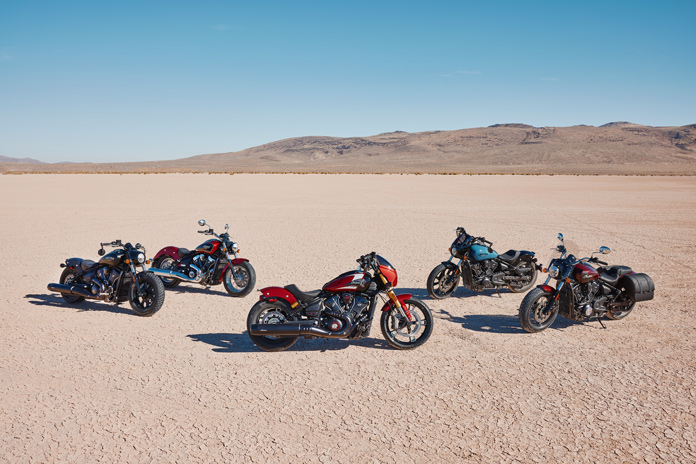
In its first major revamp since its 2015 debut, Indian’s Scout cruiser platform is all-new from the ground up, and the 2025 lineup includes five models, including some with names that will be familiar to any fan of Indian history: Scout Bobber, Sport Scout, Scout Classic, Super Scout, and 101 Scout. Three trim levels will be available, as well as more than 100 dedicated accessories.
At the heart of the Scout platform is a new engine called the SpeedPlus 1250. The V-Twin remains liquid-cooled but has been completely redesigned, punched out from 1,133cc to 1,250cc. Its bore goes up from 99m to 104mm, while its stroke remains at 73.6mm. Power goes up to 105 ponies and 82 lb-ft of torque, and the 101 Scout gets a bump to 111 hp.
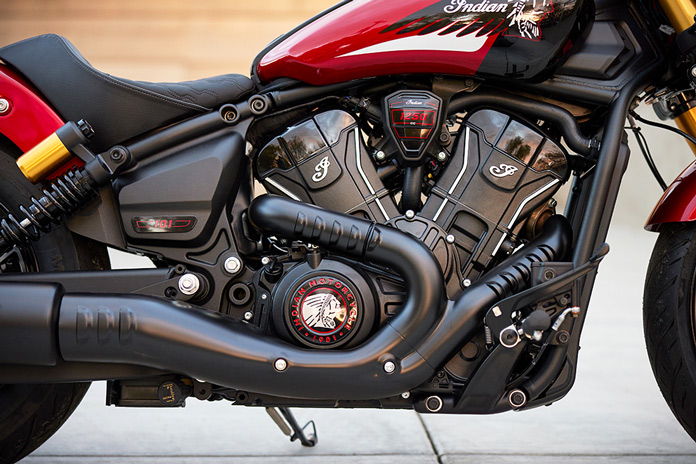
Also new is the Scout’s frame, switching from an aluminum design to a simpler steel-tube chassis intended to be easier to customize, similar to what Indian did with the Chief platform in 2021. It supplies a 61.5-inch wheelbase with a 29-degree rake and 4.8 inches of trail.
“Our top priority was to uphold the iconic namesake of Scout and ensure the new lineup is as timeless as all its predecessors,” said Ola Stenegard, director of product design for Indian Motorcycle. “For us, it was imperative to keep it clean, follow the iconic lines of Scout, and create a package that offered seamless customization. To achieve this, it all started with the steel-tube frame and all-new V-Twin engine.”
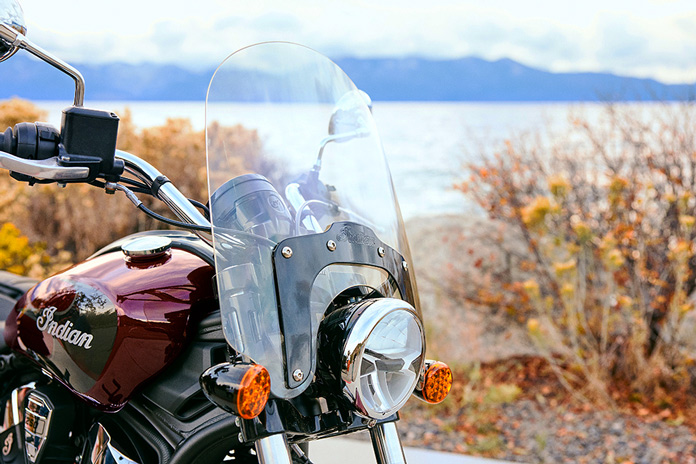
Indian says the Scout’s 25.6-inch seat height is the lowest in class. There are also new features and technology offered on certain Scout models and trim packages. All models except for the 101 Scout use a single 298mm front disc brake with a 2-piston caliper, and ABS is standard.
“As our top-selling platform, Scout has long been a staple in our lineup,” said Mike Dougherty, president of Indian Motorcycle. “We’re excited to take it to the next level and continue its evolution with a robust offering of models to meet the diverse needs of our global riding community.”
2025 Indian Scout Models
The least expensive version is the Scout Bobber, with prices starting at $12,999. It’s a low, stripped-down model with chopped fenders, blacked-out styling, bar-end mirrors, and slammed 2-inch rear suspension.
Related: Harley-Davidson Sportster S vs. Indian FTR S vs. Indian Scout Bobber | Comparison Review
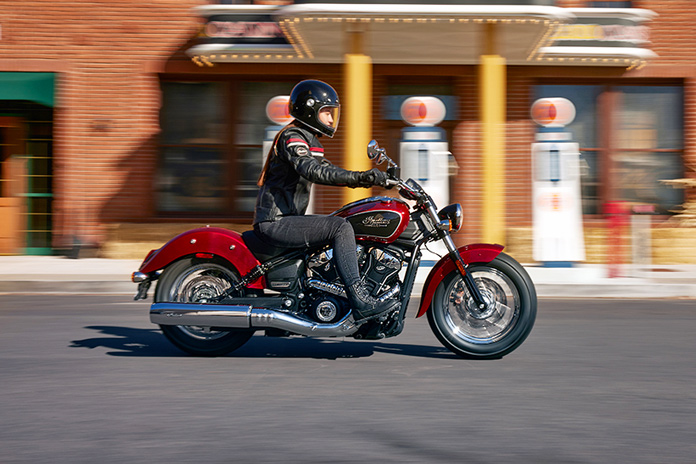
The Scout Classic (starting at $13,999) lives up to its name with a traditional design that includes flared fenders, wire-spoke wheels, relaxed ergonomics, and flashes of chrome. Their “as shipped” weights are 522 lb and 536 lb, respectively. We’ll have to wait to find out what their curb weights are when their diminutive 3.4-gallon fuel tanks are full.
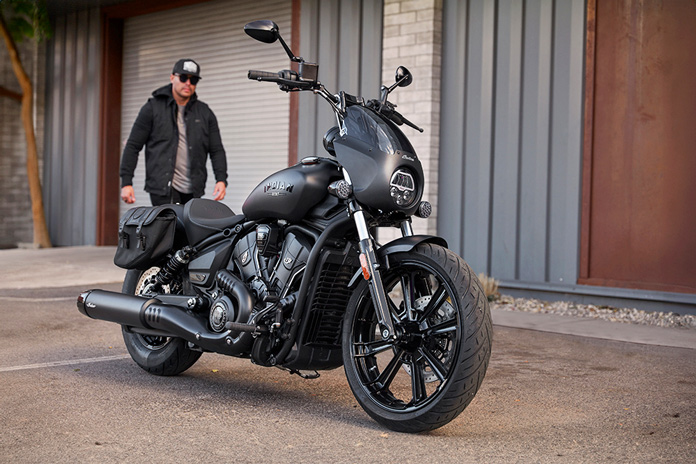
Reprising a model name from the 1930s, the Sport Scout (starting at $13,499) has a similar aggressive style as the former Scout Rogue, with a quarter fairing, 6-inch moto-style bar risers with machined highlights and a moto-style handlebar, machined triple clamps, along with a sport-style seat and a 19-inch front wheel. It weighs 528 lb as shipped.
Related: 2022 Indian Scout Rogue | First Ride Review
The Super Scout mirrors the theme of the Super Chief, equipped for the open road with a quick-release windshield, saddlebags, a passenger seat, and 3 inches of rear suspension travel. Like the Scout Classic, it has chrome finishes and wire-spoke wheels. It’s the heaviest Scout at 571 lb, and prices start at $16,499.
Related: 2019 Indian Scout with Windshield and Saddlebags | Tour Test Review
Resurrecting another legendary model name from Indian’s past, the 101 Scout packs more performance than any production Scout ever made. Its fully adjustable suspension consists of an inverted fork and piggyback rear shocks. Brakes are also high-end items, with a pair of 4-piston radial-mount Brembo front calipers pinching 320mm rotors. Like the Sport Scout, it has black moto-style risers and a moto-style handlebar, but the 101 Scout sets itself apart with a custom-stitched gunfighter-style solo seat and exclusive 101 Scout badging, paint, and graphics. Prices start at $16,999.
2025 Indian Scout Trim Packages and Accessory Collections
Three trim levels are available for certain models, starting with the Standard trim package, which includes ABS, new LED lighting, and an analog gauge with new fuel level and fuel economy readouts for the Scout Bobber, Scout Classic, and Sport Scout. Upgrading to the Limited trim level ($700) on those models adds selectable ride modes (Sport, Standard, and Tour), traction control, cruise control, and a USB charging port.
The top-of-the-line Limited +Tech trim includes the Limited features and adds keyless ignition and Indian’s 4-inch round touchscreen display with Ride Command that offers turn-by-turn navigation, point-to-point route planning, weather and traffic overlay, configurable gauges, ride stats, and optional Ride Command+ connected services. The Limited +Tech trim level adds $1,700 to the base pricing for the Scout Bobber, Scout Classic, and Sport Scout, and it’s standard on the Super Scout and 101 Scout.
Along with the five models and three trim levels, Indian will offer more than 100 accessories to enhance versatility, style, and comfort (including 32 ergonomic combinations). There are also four new accessory collections.
The Overnighter Collection is for travelers, and it includes the Solo Luggage Rack, All-Weather Vinyl Tail Bag, 20-inch Quick Release Touring Windshield, and Touring Saddlebags.
The Commuter Collection includes the Syndicate Seat, Pathfinder 5.75-inch Adaptive LED Headlight, Pinnacle Mirrors, RAM X-Grip Phone Mount, Mid Foot Controls, and Passenger Pegs.
The Stealth Collection adds aggressive style and functionality with Sleek Smoked Turn Signals, Moto Handlebar with 10-inch risers, Radial RS Mirrors by Rizoma, Bobber Saddlebags, Blacked-Out Levers, and the Pathfinder LED Headlight.
The Open Roads Collection includes Steel Front Highway Bars, LED Driving Lights, Syndicate Low Profile Passenger Backrest, Touring Backrest Pad, Rider and Passenger Floorboards, and Highway Pegs.
For more details and available colors, visit the Indian Motorcycle website.
Check out more new bikes in Rider’s 2024 Motorcycle Buyers Guide
The post 2025 Indian Scout Lineup Preview appeared first on Rider Magazine.
]]>The post Indian Scout Teaser Video Released appeared first on Rider Magazine.
]]>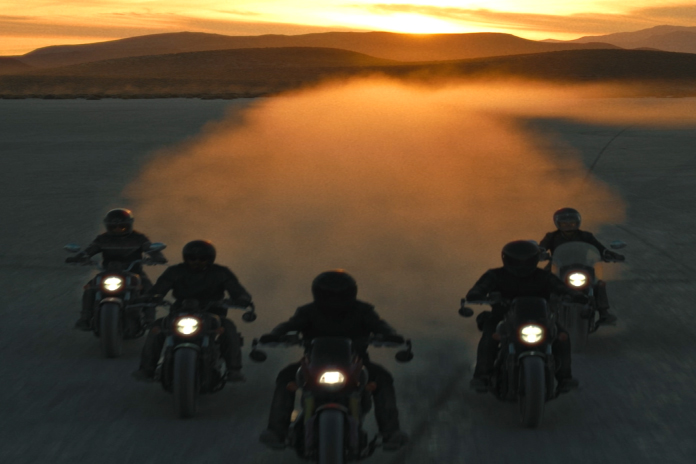
Indian Motorcycle is set to release a new Indian Scout or Scouts on April 2, and it has been teasing us with a few videos that hadn’t revealed much of anything. But today it posted a new video (see below) that shows a group of five bikes riding across a desert lakebed.
Sadly, the low light in the video doesn’t provide enough illumination to reveal many details, but there appears to be four different variants of the new Scout. For reference, Indian’s current Scout lineup consists of three main models: the classically styled Scout, the stubby Scout Bobber, and the mini-faired Scout Rogue.
In the video, the leading trio of bikes have low-mounted bar-end mirrors, while the rearmost bikes are differentiated by chrome mirrors perched atop their handlebars. Of the trailing pair, the one on the right displays a smallish windshield that suggests some sort of light-duty touring version. The one on the left could be a traditional Scout of some form.
Leading the group is a bike with a mini fairing topped with a small windscreen that looks similar to the bike on its left. One or both could be a new version of the Scout Rogue. The bike second from the left has no fairing and could be a model similar to the existing Scout Bobber.
At this point, we can only speculate based on what we see in the video, so we can’t say what could be inside them regarding their engines or chassis modifications. Full details will be released on April 2. Stay tuned!
The post Indian Scout Teaser Video Released appeared first on Rider Magazine.
]]>The post 2025 Triumph Rocket 3 Storm R/GT Review | First Look appeared first on Rider Magazine.
]]>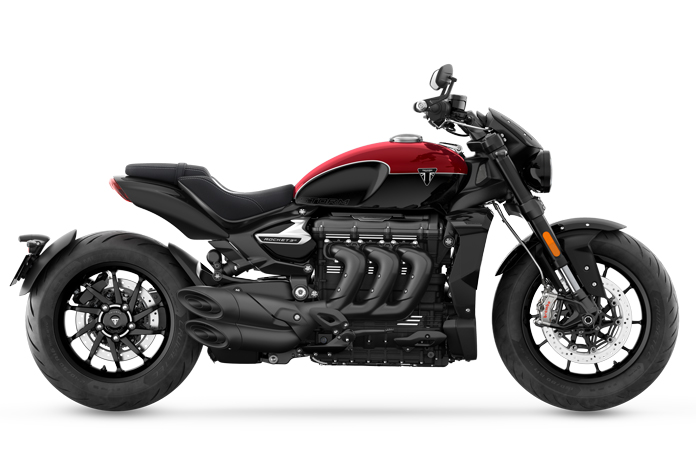
To celebrate 20 years of the Rocket 3, a muscle bike with the largest engine in a production motorcycle, Triumph has unveiled the 2025 Triumph Rocket 3 Storm R and Rocket 3 Storm GT. Their 2,458cc in-line Triple cranks out even more power – up 15 ponies to a massive 180 hp and 166 lb-ft of torque (up 3). They also feature lighter wheels, blacked-out styling, and dark color schemes.
When we tested a 2023 Triumph Rocket 3 R, we said it is “all about heart-pumping stimulation. It’s the sort of bike you lie awake at night and think about, triangulating a plan to get one into your garage. Just as Sméagol was corrupted by the Ring, the Rocket 3 will take over your thoughts and make you do naughty things. If you want to be King of the Road, there’s nothing else like it.”
Related: 2023 Triumph Rocket 3 R Review | Road Test
The two versions of the Rocket 3 Storm, R and GT, share many similarities, with most differences between the two lying in the ergonomics and paint. The R is the roadster option with a seat height of 30.4 inches and mid-position foot controls with two settings that offer 0.6 inch of vertical adjustment.
The GT version is more touring-focused with the handlebar grips 5 inches back compared to the R, a more upright riding position, a sculpted touring rider seat set at 29.5 inches and a more generously padded passenger seat compared to the R’s, with an adjustable passenger backrest. The GT also features forward foot controls with 2 inches of adjustment over three horizontal settings.
The Rocket 3’s 16-inch rear and 17-inch front wheels have been updated with a 10-spoke cast-aluminum design to reduce unsprung mass for better steering response. These two models keep their lightweight aluminum frame that uses cast and forged elements. The bikes have 4.75-gallon fuel tanks (now with the Storm name on it), and they weigh in at 699 lb for the Rocket 3 Storm R and 705 lb for the Rocket 3 Storm GT.
Slowing down these massively powered motorcycles are Brembo Stylema calipers biting two 320mm discs up front and a Brembo M4.32 4-piston radial monoblock rear caliper pinching a 300mm disc in the rear. Suspension comes from a Showa monoshock with piggyback reservoir that’s fully adjustable and 47mm Showa forks that are adjustable for rebound and compression damping.
Completing the package is a suite of rider aids and technology as standard. The Rocket 3 Storm R and GT come with lean-sensitive cornering ABS, traction control, Ride-by-Wire, a Torque Assist clutch, Hill Hold, four ride modes (Road, Rain, Sport, Rider-configurable), cruise control, a keyless ignition and steering lock, and a USB charging socket. Instrumentation comes in the form of a color TFT operated by a five-way back-lit joystick and with two information layout design themes.
Riders can choose to outfit their Rocket 3 Storm R or GT with the optional Quickshifter or any of the 50 Genuine Triumph Accessories, including foot controls, seats, plug-and-play tech, styling parts, and others.
The 2025 Rocket 3 Storm R will be available in Carnival Red with Sapphire Black, Satin Pacific Blue with Matte Sapphire Black, or Sapphire Black with Granite for $24,995. The 2025 Rocket 3 Storm GT will be available in the same colors but with the color split of the tank reversed, retailing for $25,795.
Visit the Triumph website for more information.
Check out more new bikes in Rider’s 2024 Motorcycle Buyers Guide
The post 2025 Triumph Rocket 3 Storm R/GT Review | First Look appeared first on Rider Magazine.
]]>The post 2024 Harley-Davidson Glide Models Review | First Ride appeared first on Rider Magazine.
]]>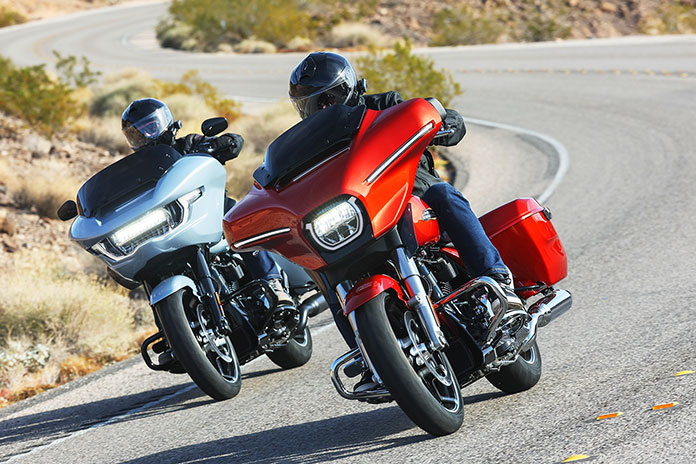
If you have only a minute, here’s what you need to know about the 2024 Harley‑Davidson Glide models: The new OE Road/Street Glides are basically last year’s CVOs but with 117ci engines instead of the VVT 121. There, now you can go back to fettling your Shovelhead.
2023 Harley-Davidson CVO Street Glide and Road Glide Review | First Ride
But, of course, there’s much more to the story about extensive revisions to America’s bestselling streetbikes. Take a ride with us from Lake Las Vegas into the surrounding remote areas.
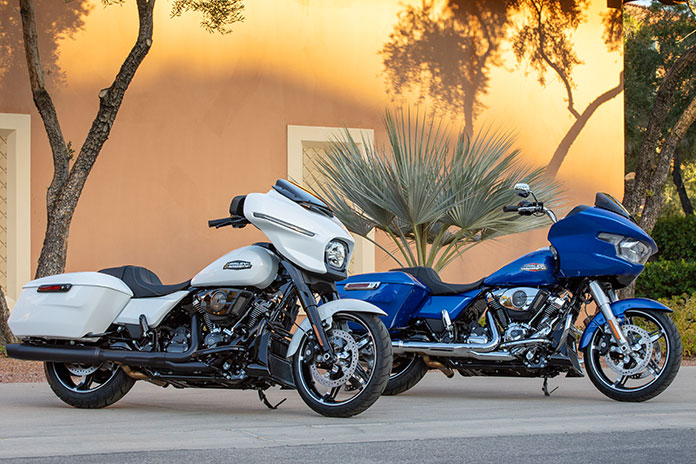
Harley-Davidson Glide CVO to OE
This is the first major update to Harley’s Grand American Touring motorcycle portfolio since the Project Rushmore bikes debuted in 2013. Almost all the attributes we enjoyed about the thoroughly updated CVO Road Glide and Street Glide that debuted last summer are seen here in OE form: the same fairings, fuel tanks, and instrument panels.
The biggest deviation from CVO to OE is found in their Milwaukee‑Eight powerplants. The 117ci engines seen here use the CVO’s liquid‑cooled cylinder heads but don’t have the variable valve timing of the 121 VVT. Other changes include a 50% larger air cleaner than the Heavy Breathers on the 107s and 114s, and the throttle body steps up from 55mm to 58mm (2.3 inches). Horsepower is bumped 3% to 105 hp at 4,600 rpm, while torque is lifted 4% to 130 lb‑ft at 3,250 rpm.
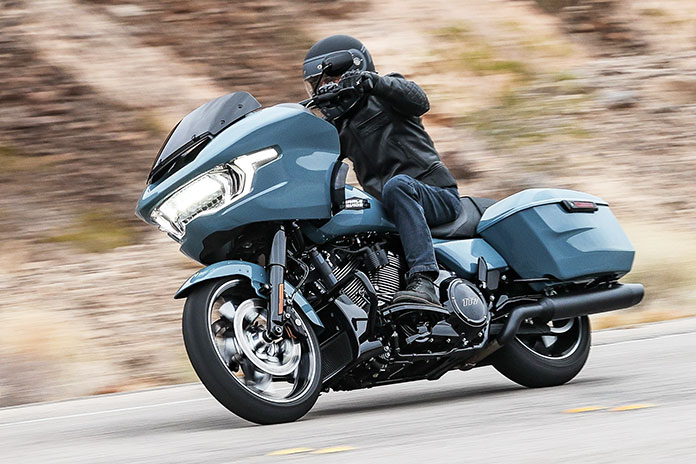
Bodywork Work
Many graybeards turned up their noses when they first saw the fresh styling of the CVO Glides – it’s human nature to reject change. Seven months later, it seems as if the MoCo faithful are softening their harsh opinions, particularly for the elegant yet familiar Street Glide.
2024 Harley-Davidson Icons and Enthusiast Collections Review | First Look
These new OE Harley-Davidson Glide models are basically identical to their CVO brethren, including the fuel tanks with chamfered upper edges that are 2 lb lighter than before but still hold 6 gallons. Further weight is trimmed by using a triple‑clamp fabricated by a liquid‑aluminum forging process, shaving off about 7 lb from this critical area. The new RG is purportedly 16 lb lighter than the previous RG Special; the SG has lost 18 lb relative to the old SG Special.
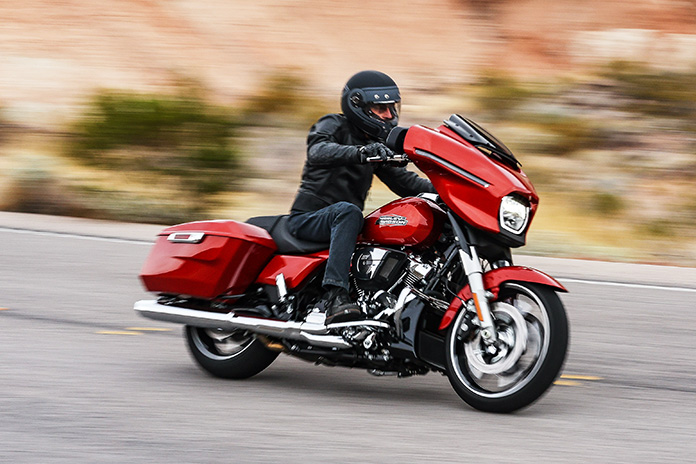
GEAR UP
- Helmet: SMK Retro Seven
- Jacket: Alpinestars Hoxton V2
- Pants: Alpinestars GPX V2
- Boots: Highway 21 Journeyman
TFT‑ease
The upgrade riders will have their eyes on most is the stunning TFT instrument panel. At 12.3 inches, it’s diagonally 90% larger than the previous screen. It includes three display options: Cruise, which is a traditional layout; Sport, with a central tach/speedo, leaving more space on the sides for customizable widget displays; and Tour, with most of the screen occupied by maps and directions.
It’s all managed by H‑D’s Skyline OS, and preferences can be set via the glove‑friendly touchscreen or the various handlebar buttons. Audio wattage has been doubled to 200 watts, sending tunes to two 5.25‑inch speakers in the fairings.
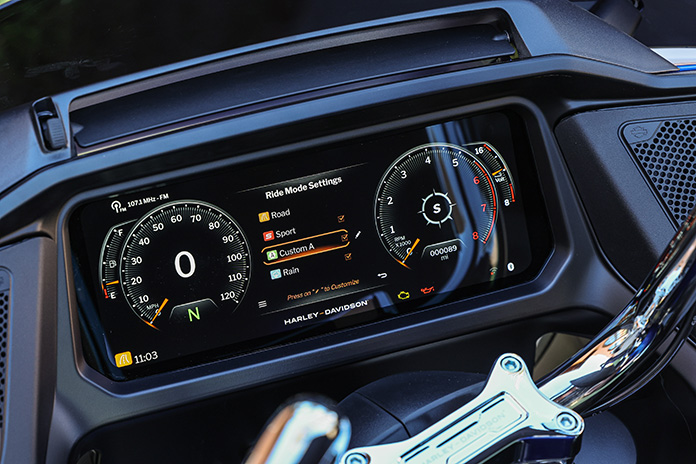
Ride modes are part of the package. Owners tap into different combinations of power delivery, engine braking, cornering ABS, and traction‑control parameters by selecting from Road, Sport, Rain, or Custom. H‑D’s Rider Safety Enhancements electronics suite is standard equipment, monitoring the linked brakes, cornering ABS, Drag Torque Slip Control, and Vehicle Hold Control.
Rather than the CVO’s inverted fork and radial‑mount Brembo calipers, the OE Glides make do with a retuned 49mm nonadjustable fork with 4.6 inches of travel, as well as the previous 4‑piston axial‑mount calipers.
The rear suspension receives a welcome upgrade, with travel up 43% from a scant 2.1 inches to a more reasonable 3 inches. Dual Showa shocks replace the old bikes’ dampers, now using emulsion technology in both instead of just one, which is claimed to improve responsiveness.
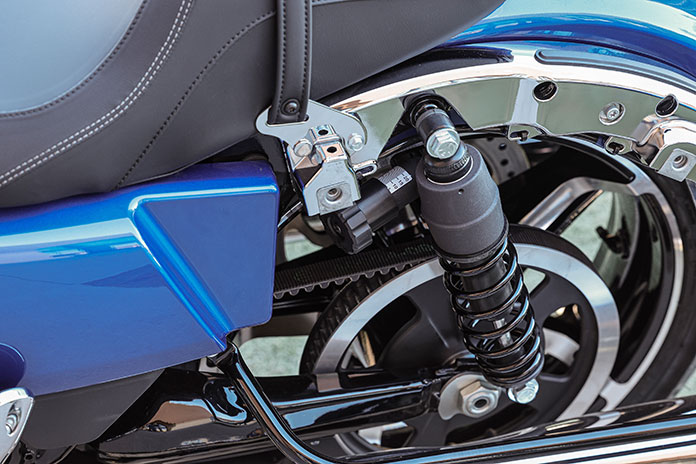
Harley-Davidson Glide Guide
For the few of you who are unaware, the Street Glide and the Road Glide are essentially the same motorcycle but with different fairings. The SG uses a version of the iconic batwing fairing that was originally introduced in 1969. Ten years later saw the arrival of Harley’s sharknose fairing on the FLT Tour Glide, which was followed in 1998 by the first official Road Glide.
Like everything in life, there is a compromise to be made in choosing the Harley-Davidson Glide that works best for you. The RG’s frame‑mounted fairing offers more wind protection, while the SG’s handlebar‑mounted batwing is more svelte but contributes to slightly heavier steering and can be affected by gusty crosswinds.
From behind the bars, the SG feels like a much smaller motorcycle than the RG with its gargantuan fairing. This makes the 838‑lb SG feel more adept during low‑speed maneuvering even though they have similar weights.
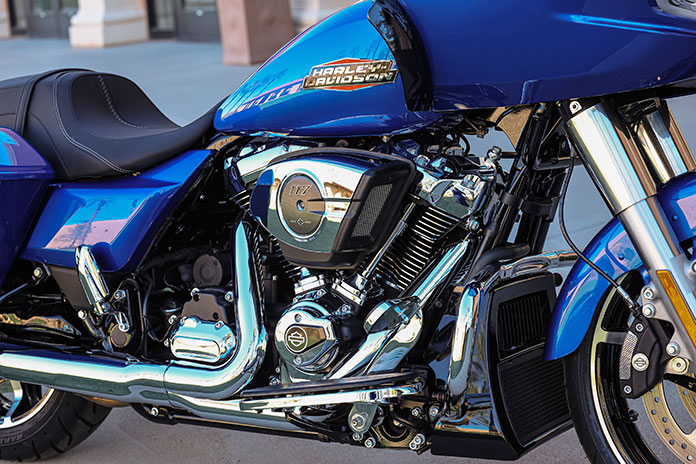
Glides Rides
I first hopped aboard a Road Glide in its Sharkskin Blue colorway, a “premium” color that carries an $850 upcharge over the standard Billiard Gray base version. The new instrument panel enhances the bike’s high‑end impression and clearly delivers info to a rider, including tire pressures. The upgraded switchgear also impresses with a higher‑quality tactileness. The RG’s cockpit includes a pair of storage compartments, and the bin on the right side is equipped with a USB‑C connector.
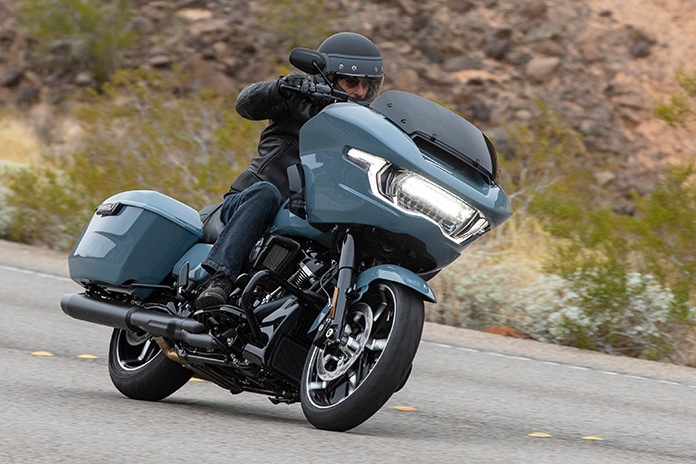
The new 117ci motor spits out stately levels of grunt at all points of its powerband. It’s only in comparison with the CVOs’ 121ci M‑8s that it comes up a bit short. Almost everyone will think it’s more than adequate. I dialed in the Road ride mode for the smooth throttle response I desired for this mostly casual ride.
While I enjoyed the full roar emitted from the exhaust system, the output from the audio system gets overwhelmed by wind noise above 65 mph. Although rated at 200 watts, it puts out 50 watts per channel, with only two speakers – the extra 100 watts will only be heard after fitting a pair of saddlebag speakers.
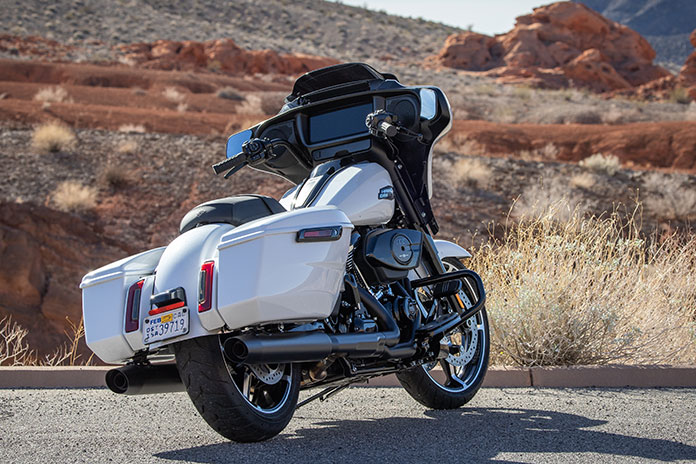
When I swapped over to a Street Glide, I enjoyed a more suitable riding position for my smaller physique. The SG’s lower handlebar feels more natural for my stature, while the RG’s bar places the grips just a few inches lower than my shoulders. The touchscreen display on the SG is also much closer to the rider than the RG’s, making it much more accessible.
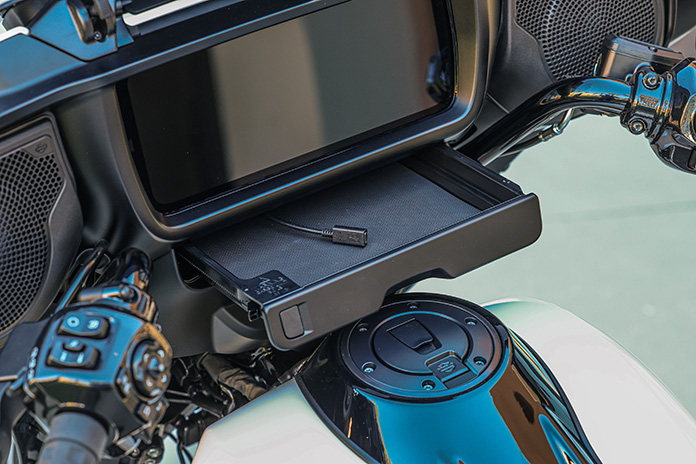
Both Glides have adjustable vanes on the sides of their fairings to redirect airflow, plus a vent at the center of the windscreens that can be adjusted to smooth the air that hits a rider’s helmet. Another much‑appreciated feature on the SG is its slide‑out storage tray directly below the instrument panel, which is super convenient for stashing any small items.
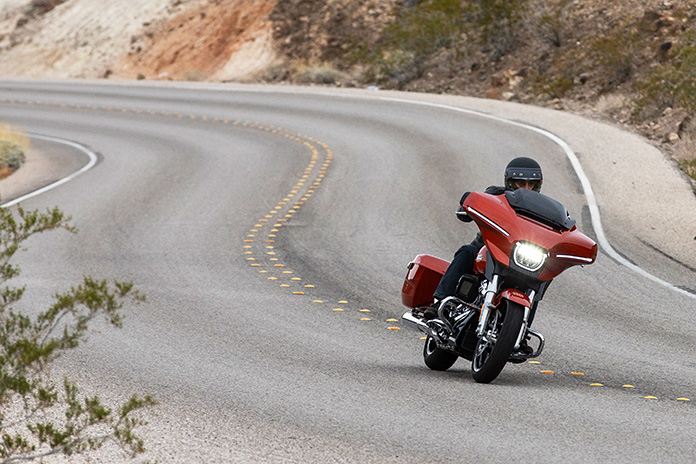
The smooth Nevada roads we traveled didn’t challenge the suspension, but the few bumps we hit made me grateful for the additional travel provided by the new shocks. They provide a major upgrade in ride quality compared to the previous shorty shocks. The brakes are plenty capable but not to the high levels of power offered by the hardware on the CVOs.
The Verdict
New OE Harley-Davidson Glide gripes are few. The heavy clutch requires a strong pull, and the 6‑speed transmission swaps cogs with a clunkiness unbecoming of a modern gearbox. But the upgraded motor is very satisfying, and the additional rear suspension travel is a major improvement that allows the Glides to glide over bumps that previously would shock a rider’s spine.
The only real impediment to pulling the trigger on a new Glide is their pricey MSRPs, starting at $25,999. Both bikes have chrome finishes as standard, while black finishes cost an extra $1,350. Color options beyond Billiard Gray add another $850.
While that’s a significant chunk of change, it’s far less than the CVOs, which are priced above $40K. If you gotta roll in style on a Harley bagger, these new Glides are a substantial improvement over the older ones. Even the graybeards will have to agree.
Check out more new bikes in Rider’s 2024 Motorcycle Buyers Guide
The post 2024 Harley-Davidson Glide Models Review | First Ride appeared first on Rider Magazine.
]]>The post 2024 Harley-Davidson Icons and Enthusiast Collections Review | First Look appeared first on Rider Magazine.
]]>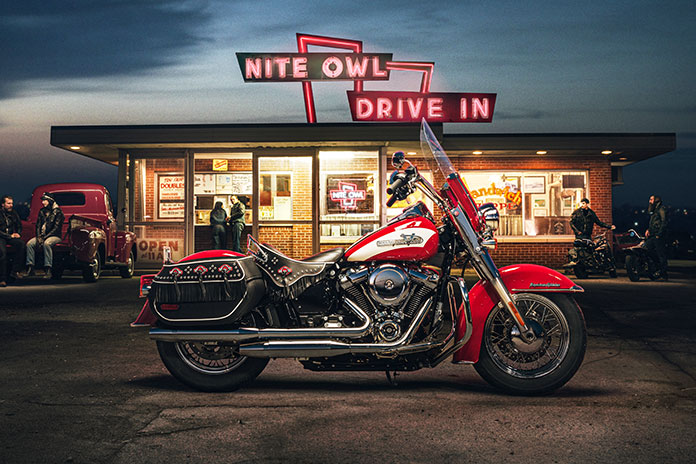
Harley-Davidson has announced the latest additions to its limited-edition Harley-Davidson Icons Motorcycle Collection and the limited-run Enthusiast Motorcycle Collection, showcasing premium factory-direct custom paint and graphic treatments and paint application technology. Both collections are available now at authorized Harley-Davidson dealers, and for those heading to Daytona Bike Week, March 2-9, the bikes will also be displayed there at the Harley-Davidson Event Display Area at Daytona International Speedway.
Related: 2024 Harley-Davidson Motorcycle Lineup Review | First Look
The Harley-Davidson Icons Motorcycle Collection is an annual program for the limited release of a new model that offers a fresh interpretation of an iconic Harley-Davidson motorcycle. Each model is individually numbered and produced only once.
The Enthusiast Motorcycle Collection models celebrate Harley-Davidson riders and are inspired by their stories and legacies. This collection of Harley-Davidson motorcycles is available in limited quantities – no more than 2,000 per model – across a curated selection of three motorcycle models.
Harley-Davidson Icons Motorcycle Collection: Hydra-Glide Revival Model
The 2024 Hydra-Glide Revival model, the fourth installment in the Harley-Davidson Icons Motorcycle Collection, celebrates the 75th anniversary of the 1949 introduction of the Hydra-Glide telescopic front suspension for Harley-Davidson E and F models. The 2024 Icons model is inspired by the look of the motorcycles ridden in era of the upcoming film The Bikeriders, which follows the rise of a Midwestern motorcycle club as seen through the lives of its members. The film is scheduled to be released theatrically in the United States on June 21, 2024.
When Hydra-Glide equipped models were introduced, the saddle of a smooth-riding Harley-Davidson FL motorcycle was an exciting way for many Americans to explore the country on the new network of interstate highways.
The 2024 Hydra-Glide Revival model is finished in custom Redline Red paint with a Birch White panel on fuel tank sides, the same design featured on 1956 models. Details include chrome “Harley-Davidson V” tank badges inspired by 1955-56 tank badges and “Hydra-Glide” script badges located on the front fender skirt. The serialized “Hydra-Glide Revival” insert on the handlebar riser cap and Icons Motorcycle Collection graphic on the rear fender identify this limited-production model.
Additional styling features include instrument graphics inspired by those on the 1954-55 speedometer. The two-tone 21-inch detachable windshield features a color-matched lower portion in Redline Red. A chrome round air cleaner cover and chrome steel laced wheels add to the nostalgic look. Front and rear fender trim, engine guard, fork covers, powertrain, and exhaust are finished in brilliant chrome.
A solo saddle is finished with a fringed and decorated leather valance, white seam piping and red contrast stitching, and a chrome rail for a nostalgic look. A matching black leather tank strap is embellished with studs and a concho. Leather and vinyl saddlebags are detailed with chrome conchos with acrylic red centers, chrome studs and leather fringe, white seam piping, and red contrast stitching. The saddlebags are water-resistant and have keyed locks for security, as well as a rigid liner so they will hold their shape season after season.
The bike features a counter-balanced Milwaukee-Eight 114 V-Twin tuned with a Screamin’ Eagle High-Flow air cleaner. For the rider focused on performance, this engine accepts all applicable Harley-Davidson Screamin’ Eagle Stage Upgrade kits.
The Softail chassis hides adjustable mono-shock rear suspension below the seat. The bike also features electronic cruise control, an LED headlamp and auxiliary lamps, and standard ABS.
Global production of the Hydra-Glide Revival model will not exceed 1,750 units, and pricing starts at $24,999.
Harley-Davidson Tobacco Fade Enthusiast Motorcycle Collection
Featuring a paint and graphics scheme inspired by the classic sunburst wood finish first seen on rock and roll guitars, bass, and drums of the 1960s, the 2024 Harley-Davidson Tobacco Fade Enthusiast Motorcycle Collection celebrates the burst of collective energy released by live music at the corner tavern, at a motorcycle rally, or the live stage at the Harley-Davidson Homecoming Festival. Comprising the Low Rider ST, Ultra Limited, and Tri Glide Ultra models, the Enthusiast collection of bikes is perfect for any music lover.
The Tobacco Fade paint treatment is applied by Harley-Davidson using state-of-the art precision paint tools designed to execute faded panel detailing. A rich caramel-colored pinstripe accents the tone of the metallic gold panel floating just outside the sunburst fade.
The fuel tank medallion is inspired by the shape and grooves of a vinyl record, while a graphic on the front fender shaped like a guitar pick, inspired by rock band and instrument logos, speaks directly to the details in the tank medallion. Finally, the bikes have an Enthusiast Collection branded logo on top of the Tour-Pak luggage carrier or rear fender.
Beyond the Enthusiast Motorcycle Collection special styling features, each model is mechanically identical to its 2024 lineup counterpart. Adding the Enthusiast paint and graphics scheme tacks on $1,900 to the Low Rider ST for a starting price of $25,299; $2,900 to the Ultra Limited ($35,399); and $4,000 to the Tri Glide Ultra ($41,999).
For more information, visit the Harley-Davidson website.
Check out more new bikes in Rider’s 2024 Motorcycle Buyers Guide
The post 2024 Harley-Davidson Icons and Enthusiast Collections Review | First Look appeared first on Rider Magazine.
]]>The post 2024 Keeway Models Announced: V302 C Cruiser and Three Scooters appeared first on Rider Magazine.
]]>
Keeway, the motorcycle company founded in Hungary in 1999 and owned by Chinese manufacturer Zhejiang Qianjiang Motorcycle Group Co., is corporate manager and co-owner of the Benelli brand and also sells motorcycles under its own name. It has announced 2024 Keeway models for the American market, including the V302 C lightweight cruiser, the 1960s-styled Sixties 300 scooter, the smaller retro Versilia 150 scooter, and the modern Vieste 200 scooter.
2024 Keeway V302 C
The V302 C lightweight cruiser is powered by a liquid-cooled 298cc V-Twin with SOHC and 4 valves per cylinder. Keeway claims 30 hp at 8,500 rpm and 19.5 lb-ft of torque at 6,500 rpm. The V302 C has a 6-speed gearbox and belt drive.
Keeway emphasizes the long and low attitude of the V302 C, which has a wheelbase of 55.9 inches, a low seat height of 27.1 inches, forward-mounted foot controls, a wide handlebar, and a claimed weight of 367 lb. An inverted fork provides 4.5 inches of travel, and dual shocks provide 1.8 inches of travel and are preload adjustable. The V302 C has single-disc brakes front and rear, and ABS is standard.
Visual highlights on the 2024 Keeway V302 C include bar-end mirrors, low-profile fenders, LED lighting, shorty drag bars, and blacked-out styling. Instrumentation is fully digital with a tachometer surrounding a speedometer, fuel gauge, gear indicator, odometer, and clock.
The 2024 Keeway V302 C is available in Black, Red, or Gray, and the MSRP is $4,999.
2024 Keeway Sixties 300
At the top of Keeway’s scooter lineup for the American market is the retro Sixties 300. It’s powered by a liquid-cooled 278cc Single with 4 valves that produces a claimed 25 hp at 8,250 rpm and 17.7 lb-ft of torque at 7,000 rpm. It has a CVT transmission and a top speed of 75 mph.
The Sixties 300 comes with a KYB fork and KYB dual shocks with preload adjustability, as well as front and rear disc brakes with Nissin calipers and Bosch ABS.
The Sixties 300 leans into its 1960s styling with a front-fender ornament, a front grille, rider and passenger quilted seat pads, and swoopy side panels. Also included is a digital display with analog gauges, LED lighting, under-seat storage, and a rear luggage rack.
The Keeway Sixties 300 is available in Sky Blue, Matte Black, or White with an MSRP of $5,299.
2024 Keeway Versilia 150
The Versilia 150 scooter is the smaller sibling of the Sixties 300 and is powered by a 150cc Single with a claimed 9.7 hp at 7,000 rpm and 7.7 lb-ft of torque at 6,500 rpm, paired with a CVT transmission. Braking is provided by a single front disc and a drum in the rear.
The Versilia 150 takes design cues from the Sixties 300 but with a more modern twist. Details include a stitched seat, a stacked LED headlight, under-seat storage, and a rear storage rack. Instrumentation includes a speedometer, odometer, fuel gauge, and clock. The Versilia 150 also includes a locking glove box with a USB port, a backpack hook, and keyless ignition.
The Keeway Versilia 150 is available in Gray, Red, or White with an MSRP of $2,499.
2024 Keeway Vieste 200
The Vieste 200 takes on a more modern appearance compared to the Sixties 300 or the Versilia 150. It’s powered by an air-cooled 172cc Single that makes a claimed 11.4 hp at 7,500 rpm and 8.9 lb-ft of torque at 5,500 rpm with a top speed of 59 mph and a CVT transmission. Suspension is provided by a telescopic fork and dual rear shocks, and braking comes from 240mm front and 215mm rear disc brakes.
Instrumentation on the Vieste 200 comes in the form of analog gauges for the speedometer and tachometer along with digital displays of temperature, odometer, trip meter, clock, and fuel level. All lighting is LED, and the scooter comes with rear grab rails, two storage pockets above the footwell, a USB port, and a large storage bin under the seat.
The Vieste 200 is available in Blue, Gray, or White with an MSRP of $3,399.
Visit the Keeway website for more information.
Check out more new bikes in Rider’s 2024 Motorcycle Buyers Guide
The post 2024 Keeway Models Announced: V302 C Cruiser and Three Scooters appeared first on Rider Magazine.
]]>The post 2024 Moto Morini Calibro Review | First Look appeared first on Rider Magazine.
]]>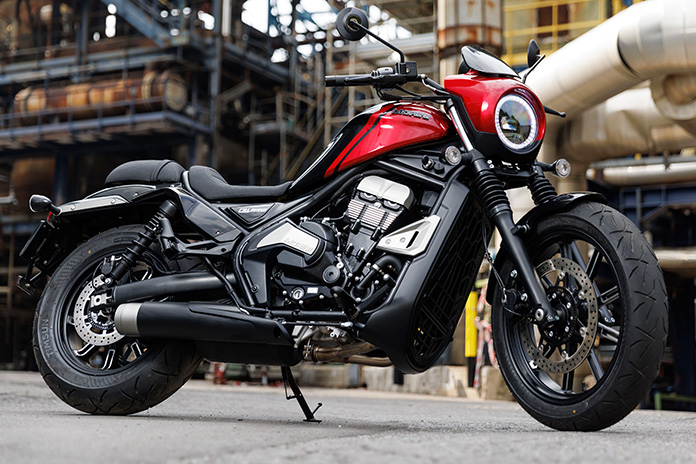
At the recent AIMExpo powersports show in Las Vegas, Italian motorcycle brand Moto Morini announced the release of a new cruiser: the 2024 Moto Morini Calibro. Also unveiled by the company at the expo were the 2025 Moto Morini X-Cape 1200 adventure bike and the 2025 Corsaro 750 and Corsaro Sport sportbikes.
The Moto Morini Calibro, which will also be available in an all-black bagger version with hard saddlebags, front fairing, and a windscreen, is powered by the same 649cc parallel-Twin with DOHC and 4 valves per cylinder as the Moto Morini Seiemmezzo SCR scrambler and STR roadster. When we tested those two bikes in foothills of the Italian Alps, our reviewer said the engine “feels refined and accessible, with a linear build of power and torque from 3,000 rpm all the way to the hard-action 10,500-rpm limiter.”
Related: 2023 Moto Morini Seiemmezzo SCR and STR Review | First Ride
Moto Morini says the engine has been revised for the cruiser to “transmit pleasurable driving pulsations while ensuring smooth running.” The Calibro also has a belt final drive, as opposed to the chain final drive on the Seiemmezzos.
Stopping power comes from a 2-piston front caliper biting a 320mm disc and a 1-piston rear caliper with a 255mm disc, and Bosch ABS is standard. A 41mm fork provides 5.5 inches of travel, while preload-adjustable dual shocks give a vintage look and offer 4.3 inches of travel.
The Moto Morini Calibro has adjustable footpegs, either forward for a more relaxed seating position or back for a sportier ride. The seat height is 28.3 inches, and the pillion can be removed and replaced with an accessory rear shell that follows the fender line.
The bike has a 58.7-inch wheelbase and rides on aluminum spoked tubeless wheels, 18 inches in the front and 17 inches in back. It has an approximately 4-gallon tank and a dry weight of 441 lb.
Pricing for the 2024 Moto Morini Calibro has not yet been announced.
Check out more new bikes in Rider’s 2024 Motorcycle Buyers Guide
The post 2024 Moto Morini Calibro Review | First Look appeared first on Rider Magazine.
]]>
